













































































Last July, we had a terrific opportunity to share all that Behrend has become when the University’s Board of Trustees held its summer meeting on campus and we kicked off our 75th anniversary year.
The Trustees’ visit was also an opportunity to share where we see Behrend headed—pursuing a vision defined by enhanced student success, growing academic excellence, expanded research, and increased regional impact.
In 1948, Mary Behrend officially gifted her Glenhill estate to Penn State to honor the memory of her husband, Ernst, who together with his brother, Otto, founded Hammermill Paper Company. The Behrend brothers were entrepreneurs and innovators. They were ahead of their time in embracing technology and deploying progressive business practices.
That same spirit of inventiveness and discovery is alive and well at Penn State Behrend today—and while we honor our past, it is in our DNA to look to an even better future.
In 1973, we became the first college of Penn State outside of University Park to deliver Penn State bachelor’s and master’s degrees. Since then, we have had near continuous growth in enrollment, academic offerings, research and outreach activity, and philanthropy. Our numbers tell a story of impact:
• We’re educating students in nearly 50 programs of study on our 850-acre campus and online through World Campus.
• We’re bringing millions of dollars in sponsored research to the Erie region annually—nearly $10 million in the most recent year reported.
• We’re collaborating with more than 500 companies and organizations through career fairs, campus visits, research and design projects, and our James R. Meehl Innovation Commons.
• We’re leading a $26 million women’s health initiative with Magee-Womens Research Institute.
• We’re partnering with more than 20 companies in our Knowledge Park, including the newest park occupants, Truck-Lite and Kyocera AVX.
• We’re engaging with more than 32,000 youth and educators in science, technology, engineering, arts, and math (STEAM) programs each year.
Our success was not produced in a vacuum, of course. It has taken the vision, talents, and energy of a great many people—University and College leadership, faculty, staff, alumni, donors, and friends. It has taken everyone working together to build the Penn State Behrend of today.
We know from Mary Behrend’s remarks at the dedication of the Behrend Center in 1948 and from her continued engagement in the years that followed that she had high hopes for our future. I believe that she would be pleased—likely, amazed—to see our growth, from our humble beginnings to the exceptional place we are today.
 Chancellor Ralph Ford rmf7@psu.edu
Chancellor Ralph Ford rmf7@psu.edu
Celebrating 75 years: From its start with just 146 students in 1948, Penn State Behrend has become one of the largest Penn State campuses. Though much has changed since the first students began their education at what was then the Behrend Center, a commitment to delivering a high-quality academic experience and meeting the land-grant mission of the University in northwestern Pennsylvania remains. Read more about the college’s history and future beginning on page 8.


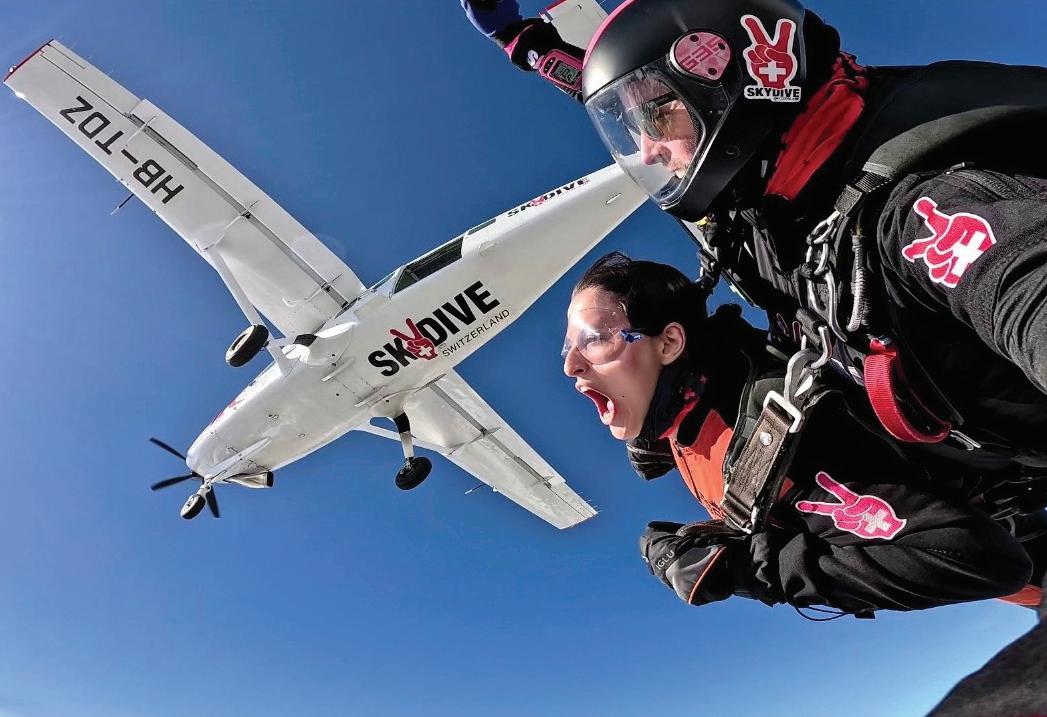

This summer, Penn State Behrend presented the college’s highest award, the Behrend Medallion, to former Gov. Tom Ridge, a longtime Congressman from Erie who also served as the first secretary of the U.S. Department of Homeland Security.
The medallion was presented at the college’s annual Glenhill Appreciation Dinner, where Ridge was introduced by friend Thomas Hagen, chairman of the board of Erie Insurance Group.
In introducing Ridge at the dinner, Hagen, who received the Behrend Medallion in 2018, said, “Tom serves by being a conscience for all in the public sphere—a reminder that, despite our differences and disagreements, nothing is ever solved without respect, compromise and, above all, civility.”
A 1972 graduate of Penn State Dickinson Law, Ridge was the first Vietnam War combat veteran to serve in the U.S. Congress. He was elected to six terms in the U.S. House of Representatives. In 1994, he was elected governor of Pennsylvania, winning re-election in 1998.
Ridge has been a longtime supporter of Penn State Behrend. As governor, he approved the original funding for the college’s Knowledge Park, and he was instrumental in securing $30 million in
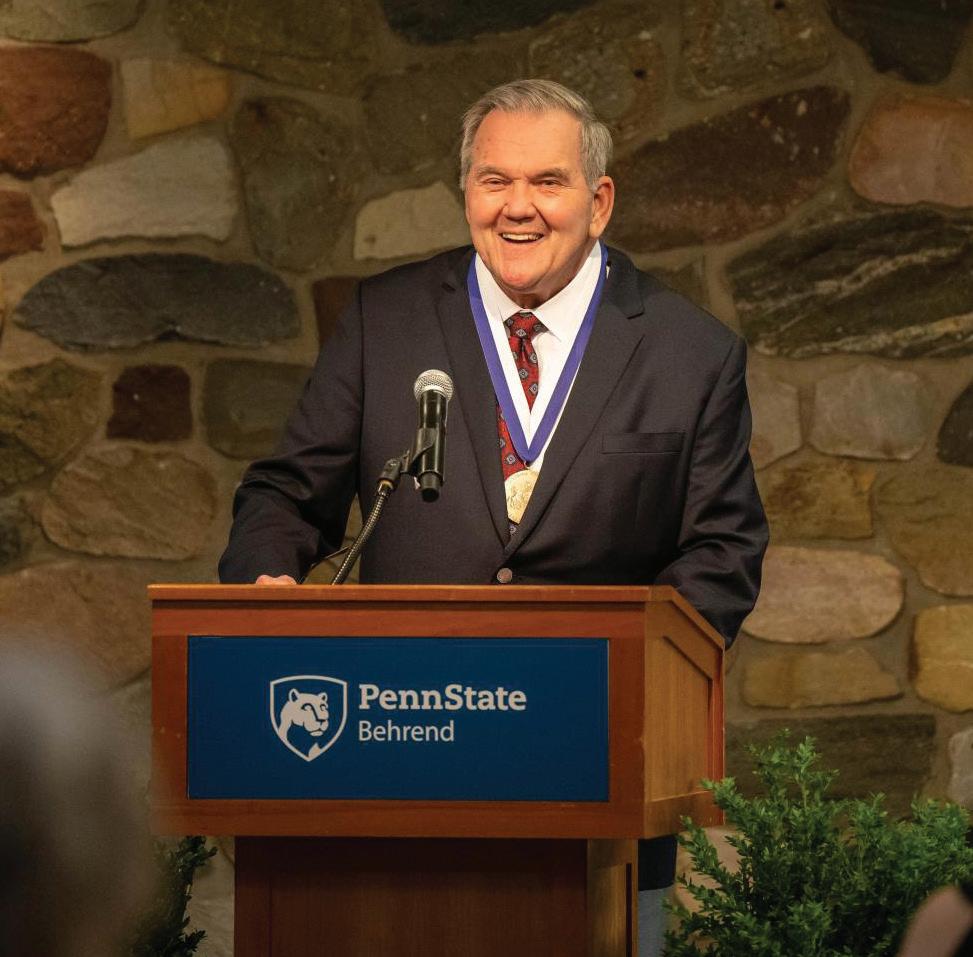
funding for the Jack Burke Research and Economic Development Center.
In the wake of the September 11, 2001, terror attacks, Ridge became the first secretary of the U.S. Department of
Homeland Security.
Today, he is chairman of Ridge Global, a consulting firm that provides solutions to risk-management issues, including cybersecurity and international security.
“ TOM SERVES BY BEING A CONSCIENCE FOR ALL IN THE PUBLIC SPHERE—A REMINDER THAT, DESPITE OUR DIFFERENCES AND DISAGREEMENTS, NOTHING IS EVER SOLVED WITHOUT RESPECT, COMPROMISE AND, ABOVE ALL, CIVILITY.”
—Thomas Hagen, chairman of the board of Erie Insurance Group
The Pennsylvania chapter of the American Institute of Architects selected Penn State Behrend’s Federal House for a 2023 Architectural Excellence Design Award. The project, which was led by a design team at GBBN Architects, was one of five in the state selected for an AIA “honor award.”
The $6.6 million renovation and expansion of the Federal House began in 2021, preserving an original building believed to be the oldest brick structure in Harborcreek Township and incorporating a modern addition. A glass-walled walkway with office suites connects the two sections. The new portion of the building includes classrooms, collaborative meeting rooms,
and a 100-person event space.
“So many times, when you add to an existing or historic building, the presence of that building gets lost or muddled,” said one of the jurors who reviewed the AIA award nominees. “In this case, it was kept as pure and pristine as possible. Then, the building was allowed to change as it turned the corner and went up the hill.”
The Federal House project created a new home for the Susan Hirt Hagen Center for Community Outreach, Research and Evaluation (CORE), which provides school and community programs to more than 3,000 youth in the Erie region every year as well as evaluation services to youth-related organizations.
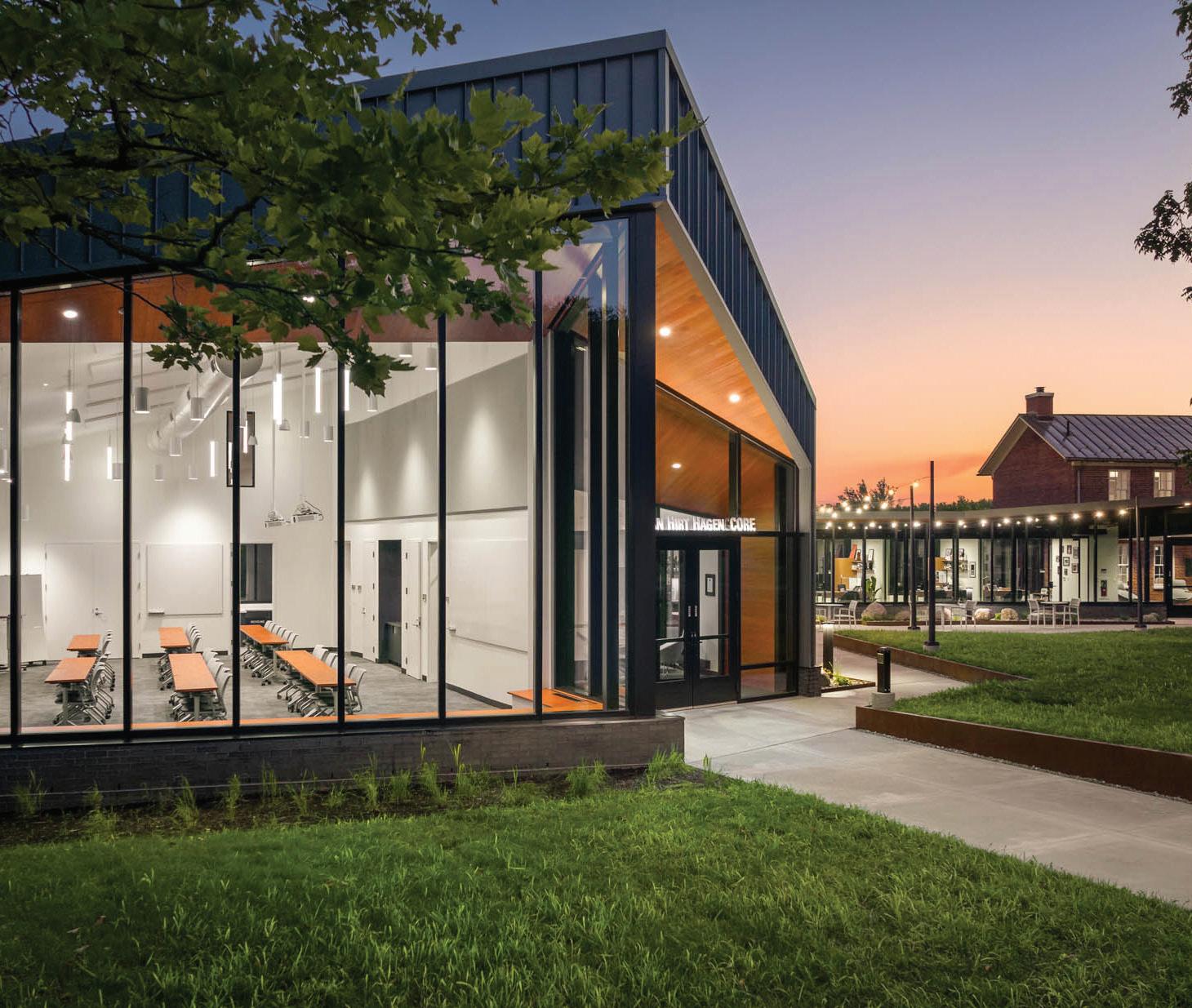
COLLEGE EARNS SILVER STARS RATING FOR SUSTAINABILITY EFFORTS
Penn State Behrend recently earned a silver rating from STARS, the Sustainability Tracking, Assessment and Rating System. The designation, which is valid for three years, is a measure of the college’s work toward environmental, social, and economic sustainability. Behrend previously held a bronze rating from STARS, which is a program of the Association for the Advancement of Sustainability in Higher Education. No other college in northwestern Pennsylvania holds a STARS rating.
The college’s initial rating in 2020 provided a baseline assessment of Behrend’s sustainability work, which is viewed through five primary categories: academics, engagement, operations, planning and administration, and innovation and leadership.
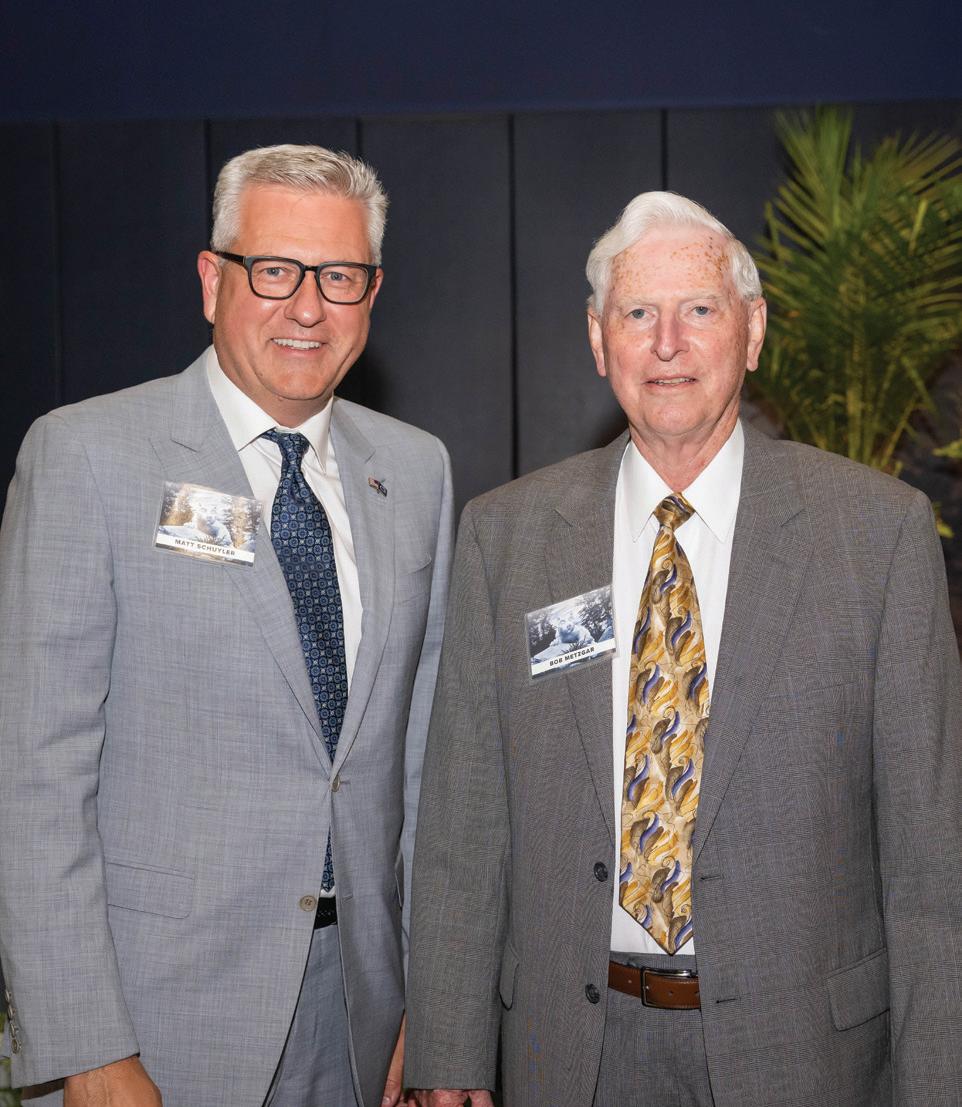
The University’s Board of Trustees held its summer 2023 meeting at Penn State Behrend. The visit gave Chancellor Ralph Ford an opportunity to share Behrend’s progress on a number of strategic fronts and the college’s vision for the future, which includes building on our Open Lab model of learning and discovery, on programs and initiatives to inspire student success, and on our growing research enterprise.
“We see Behrend as an Open Lab, a collaborative space where learning and discovery are applied in novel ways that benefit not only our students, who gain career-building, real-world experience, but also our partners in business, industry, and the nonprofit community, who tap into that energy and ingenuity,” said Ford.
The two-day visit included a community dinner with remarks by Penn State President Neeli Bendapudi (pictured at right), Chair of the Board of Trustees Matthew Schuyler (pictured above left with Trustee Emeritus Robert Metzgar), and Chancellor Ford. Additional events, meetings, and tours provided the opportunity for students, faculty, staff, and members of the college’s Council of Fellows to showcase Penn State Behrend’s strengths and distinctions.
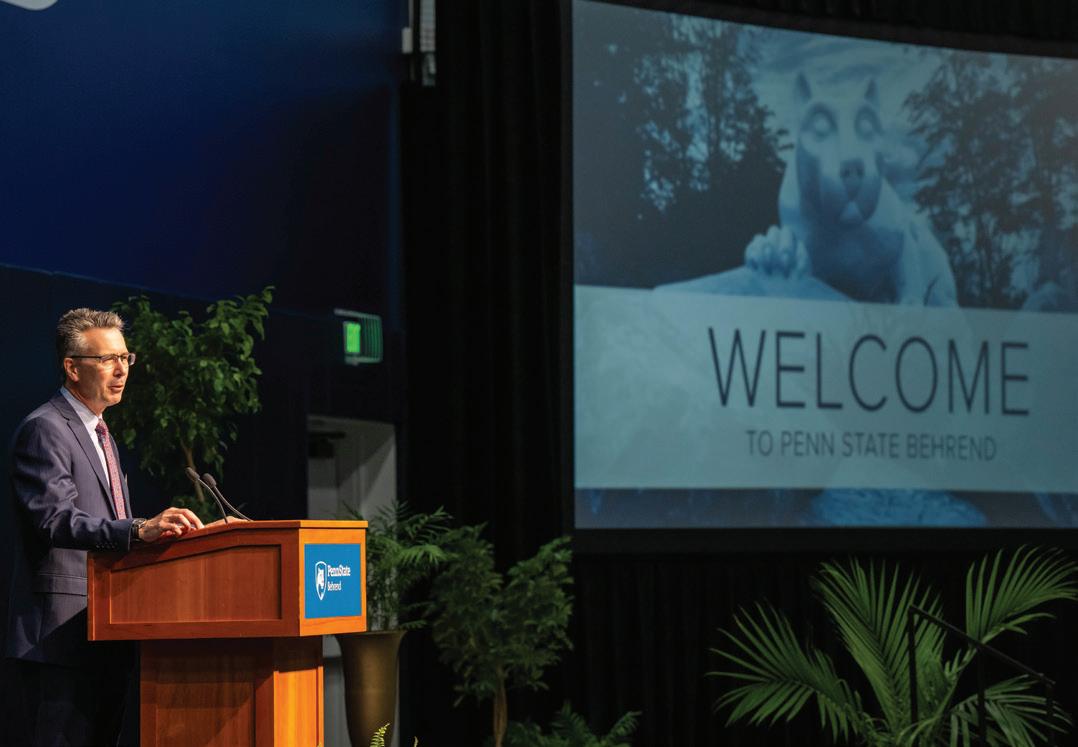
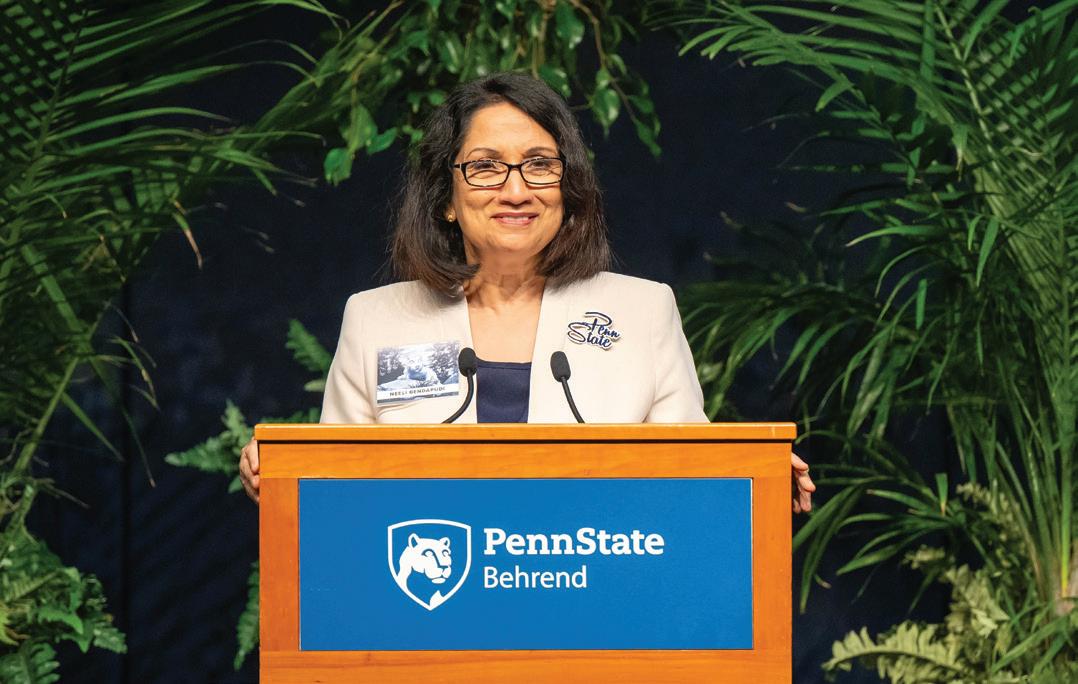


The Association to Advance Collegiate Schools of Business (AACSB) has extended its accreditation of the Black School of Business at Penn State Behrend until 2028. The extension follows an intensive site visit and review by an AACSB Peer Review Team.
Fewer than 6 percent of all colleges and universities obtain AACSB accreditation. The process recognizes business schools that excel in learning and teaching, strategic management and innovation, academic and professional engagement, and active participation by students, faculty, and staff.
The Black School of Business was first accredited by AACSB in 2003. To maintain accreditation, schools must undergo a review every five years.
Kyocera AVX, a global manufacturer of advanced electronic components, plans to build an approximately 50,000-squarefoot production facility in Knowledge Park at Penn State Behrend. The facility will serve as a corporate headquarters and manufacturing base for a new division created by Kyocera’s purchase of Bliley Technologies, an Erie-based manufacturer of crystal oscillators and low-noise frequency-control products for the aerospace, defense, and commercial satellite industries.

“This new manufacturing hub will align with and advance Project RESOLVE,” Chancellor Ralph Ford said. “Kyocera AVX sees value in being part of our campus and having access to our Open Lab resources, including laboratories, faculty expertise, and a consistent pipeline of student and graduate talent.”
The new building will support Kyocera’s efforts to expand into vehicle electrification and battery-charging technology—a focus of Behrend’s Project RESOLVE, a regional manufacturing strategy and a planned Center for Manufacturing Competitiveness in Knowledge Park.

Phase Two of trail improvements in Wintergreen Gorge was recently completed, extending the aggregate-topped path to Trout Run. The compacted aggregate surface is porous, allowing rain to penetrate it, but solid enough to make the trail more accessible to visitors in wheelchairs and those pushing strollers. A new boardwalk protects a marshy area near Fourmile Creek, and wattle fencing discourages users from creating additional footpaths that can damage vegetation and trees and cause erosion along the creek bank.
Phase Three of the improvement plan will entail removal of a culvert and creation of a bridge across Trout Run. That phase will begin once funding is secured, possibly in the fall of 2024.

THOMAS C. HOFFMAN II ’88, an attorney with the Erie firm of Knox McLaughlin Gornall & Sennett who began his college career at Penn State Behrend, was recently named one of thirteen Penn State Alumni Fellows for 2023.
The lifelong title of Alumni Fellow is the highest award given by the Penn State Alumni Association.
As a lawyer and certified public accountant, Hoffman has represented thousands of companies and individuals on business, estate, trust, and tax
matters. He helped found the Knox Law Institute, through which he contributes to programs on topics such as business succession planning, estate planning, and tax law.
Hoffman was integral in establishing Penn State Behrend’s Center for Family Business, an outreach effort of the Black School of Business. He also serves on Behrend’s Council of Fellows Board of Directors and the University’s Planned Giving Advisory Council.
In the Erie community, Hoffman is a founding board member of the Erie Center for Arts and Technology, serves on the board of the Hagen History Center, and is a past executive board member of the Erie Regional Chamber and Growth Partnership.
Hoffman and his wife, Paula ’87, live in Erie and are life members of the Alumni Association. They have three children— Christine ’19, Paul ’20, and Thomas III ’20.
MARY GOOD LAWRENCE ‘01, deputy manager of the International Space Station Vehicle Office at NASA’s Johnson Space Center, has been named the 2023 recipient of Penn State Behrend’s Distinguished Alumni Achievement Award.
The award is presented annually to a Behrend graduate who has made significant contributions to their profession, their community and the college.
Lawrence graduated from Penn State Behrend in 2001 with a degree in Mechanical Engineering. She began her NASA career in 2002 as a member of the flight control team, later moving into operations lead roles for the International Space Station.
In her current role, she is responsible for maintaining Space Station systems to ensure the safety of seven astronauts as they orbit 200 miles above the Earth. She previously served as one of about thirty NASA flight directors responsible for managing operations for all human spaceflight programs. In 2018, she received the NASA Outstanding Leadership Medal for actions as the lead flight director for the 54th expedition to the Space Station.
During her time at Penn State Behrend, Lawrence was a member of the women’s volleyball team and the first-ever women’s water polo team. She was inducted into Behrend’s Athletics Hall of Fame in 2010. She served as the keynote speaker at the college’s Richard J. Fasenmyer Engineering Design Conference in 2016 and delivered Behrend’s commencement address in 2019.
Lawrence lives in League City, Texas, with her husband, Andrew Lawrence, a 2000 Penn State alumnus, and their children, Alene and Samuel.
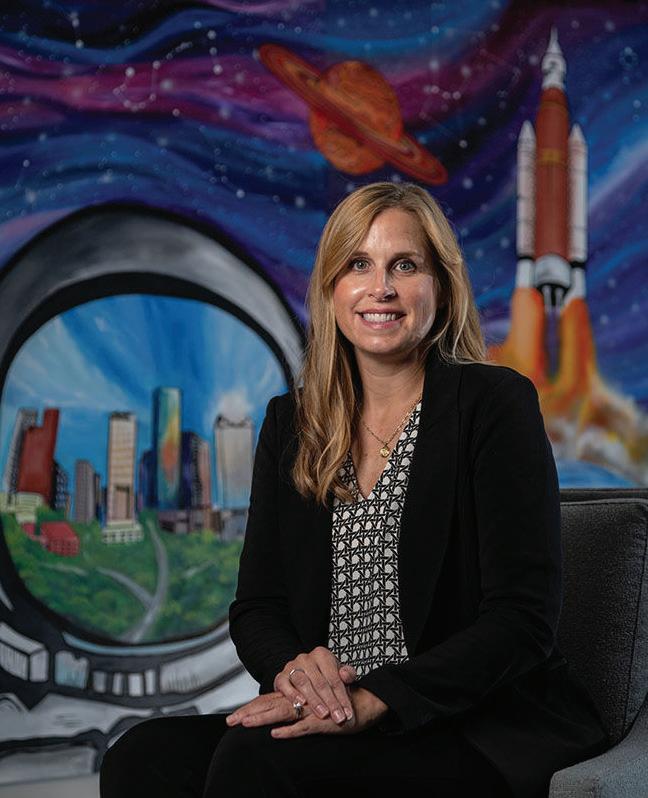

REV. CHARLES BROCK, a retired Penn State Behrend faculty member and community advocate, died November 1, 2023. He was 88.
Brock was born and raised in Erie and subsequently received degrees from Carnegie Mellon, Harvard, and Oxford universities. After returning to Erie from Oxford, where he served as a fellow, chaplain, and teacher of theology for thirty-five years, he taught courses in comparative religion at Behrend. He was particularly proud of the course Mega Issues, which he developed and taught with colleagues from all four of Behrend’s academic schools, examining complex issues affecting the world. He founded both the Brock Institute on the American Dream and the Public Policy Initiative in the School of Humanities and Social Sciences.
He is survived by his wife, Mary Lincoln Brock; three stepchildren; and nine step-grandchildren.

MESTER, a retired assistant professor of logic and philosophy, died November 16, 2023. He was 84.
Mester was born in Chicago and attended Notre Dame Preparatory school and studied for the monastic life. After taking simple vows, he became Brother Phillip, O.P. After leaving the monastery, he began
a long teaching career, first at St. Catherine’s College, then at Penn State Behrend, where he taught courses in philosophy for more than forty years. He was a beloved teacher and academic adviser.
He is survived by his wife, Cathy, a retired Penn State Behrend lecturer in speech communication; his two children, Cari Ann and Clark; and two grandchildren.

BRENT CRANDALL, supervisor of trades maintenance and mechanical work, died December 28, 2023, after a long battle with cancer. He was 53.
Crandall joined Behrend in 2011 after many years as an electrician with a regional electrical contractor. He was an avid dirt track racecar driver, competing in the Super Sportsman and Pro Stock Division at Eriez Speedway and Stateline Speedway for nearly 25 years.
Crandall is survived by his wife, Carol, who works in Housing and Food Services, and three children, Olivia, Ben, and Nick, all graduates of Penn State Behrend.

ERIC OBERT, retired associate director of Pennsylvania Sea Grant, died December 28, 2023. He was 72. Obert earned a Biology degree
from Penn State, began his career with the Pennsylvania Fish Commission and later worked for the Department of Environmental Protection before joining Pennsylvania Sea Grant, administered by Penn State Behrend. He was an avid fisherman and could often be found on an area lake in his boat. After his retirement, Obert stayed connected to his work community by serving on the Presque Isle Park Advisory Committee.
He is survived by four children and fifteen grandchildren.
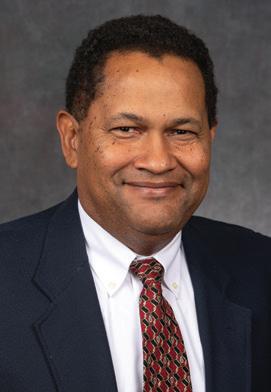
DR. DIPO ONIPEDE, associate professor of mechanical engineering, died January 9. He was 63.
Onipede earned a bachelor’s degree in civil engineering from Columbia University and a doctorate from UCLA. He joined the School of Engineering as a faculty member in 2003 and also recently served as associate director of academics for the school. He was highly engaged as a professor, adviser, and mentor, guiding many students in their academic studies and providing counsel to other faculty members as well. He was known for his calm, kind, and gentle nature.
Onipede is survived by his wife, Selin; daughter, Yeshim; and son, Kerem.
The School of Engineering is working to establish a scholarship fund in Onipede’s memory. Anyone wishing to contribute to the fund can do so at https://raise.psu.edu/DipoMemorial

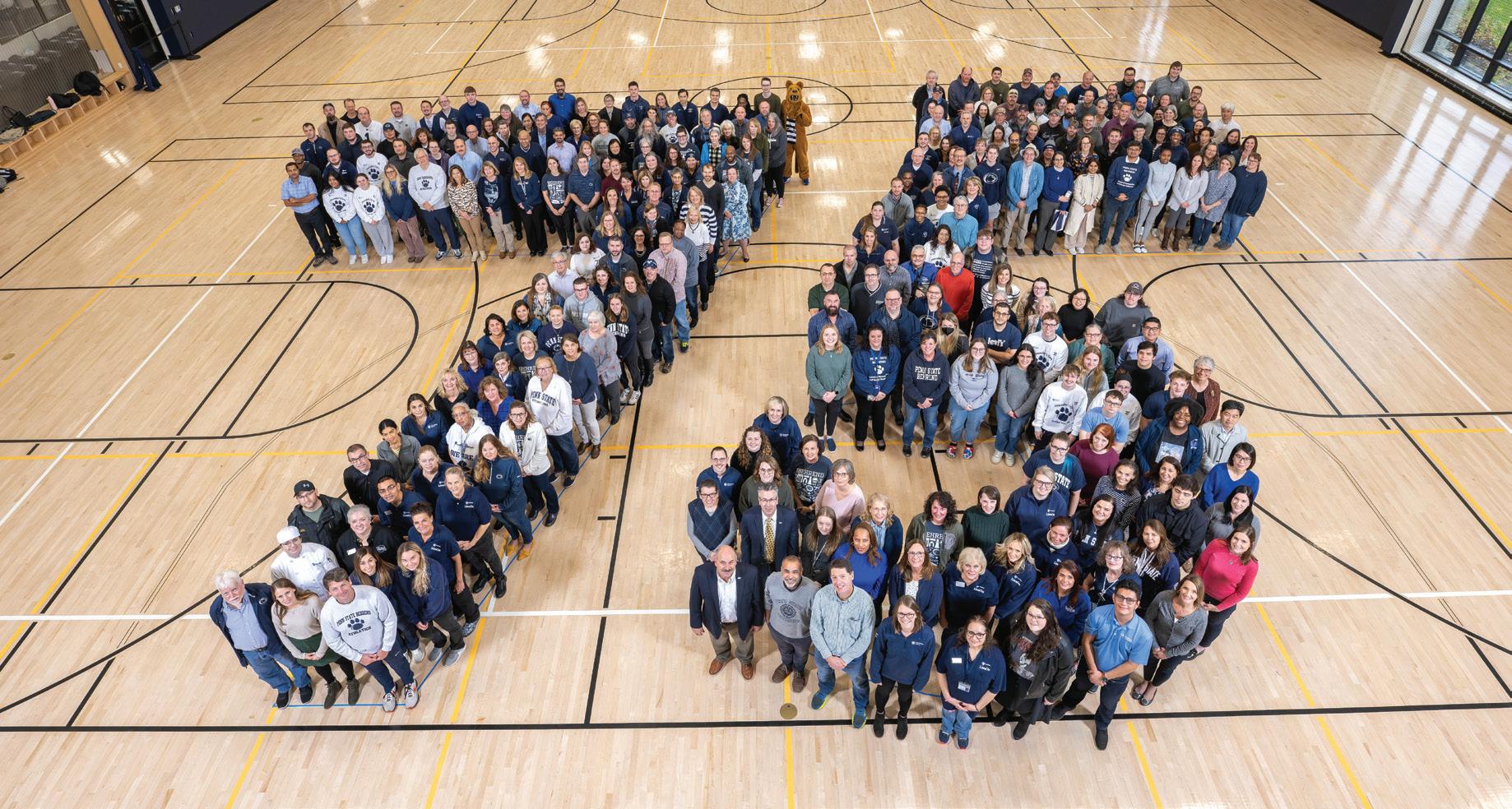
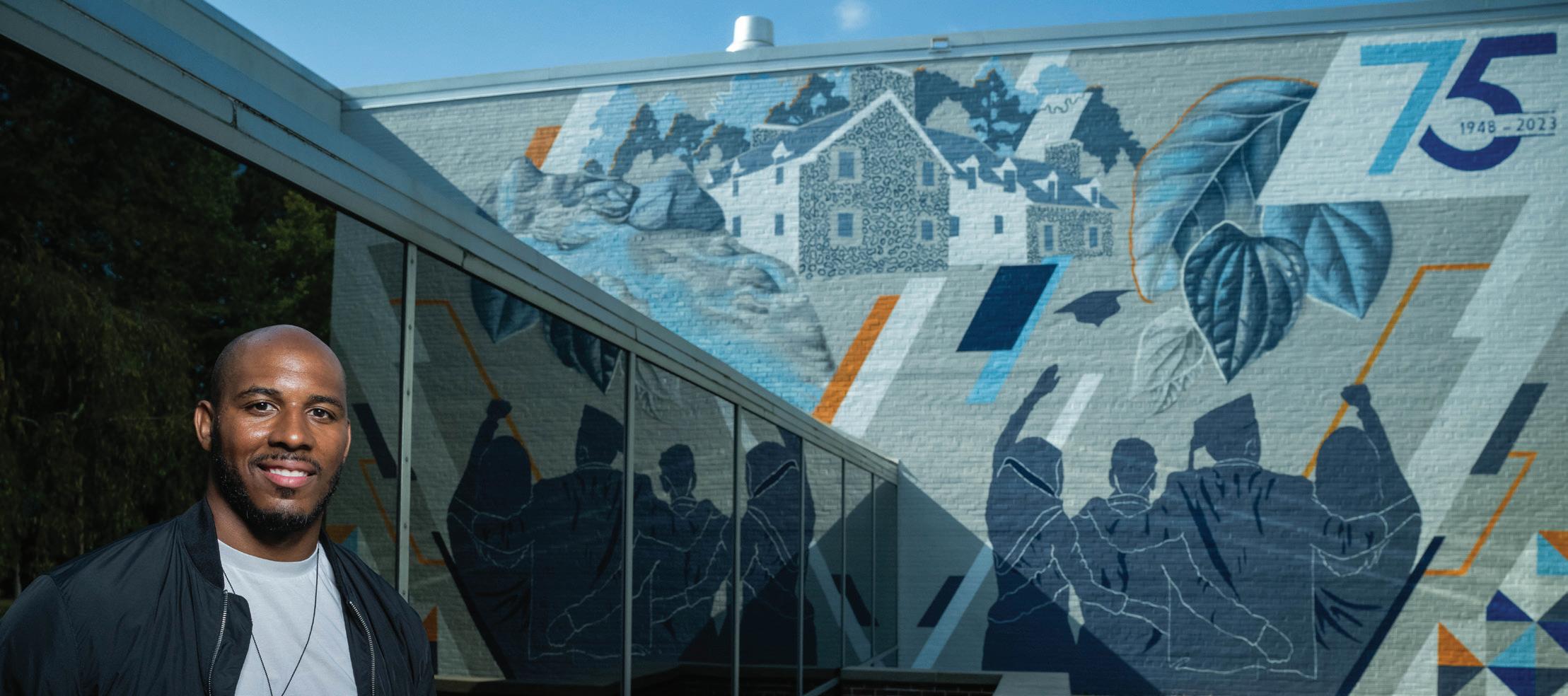
In 1948, Mary Behrend had the idea to gift her family’s Glenhill Farm to Penn State to create a university presence in Erie. Imagine what she’d think of how her gift has grown.
• From 146 students in that first year to more than 3,300 learning on campus plus more than 950 online in Behrend programs offered through World Campus
• From single-year only courses to 100+ majors, minors, and certificates offered through four academic schools
• From a footprint defined by a farmhouse, outbuildings, and pastures to an 854-acre campus that is second in size only to University Park
• From a rural outpost to a major College of Penn State, fulfilling the University’s three-fold mission of education, research, and outreach in northwestern Pennsylvania and beyond
As we turn 75, it’s clear we have a lot to celebrate in our past—our people, our successes, our impact—and a lot to look toward in our future.
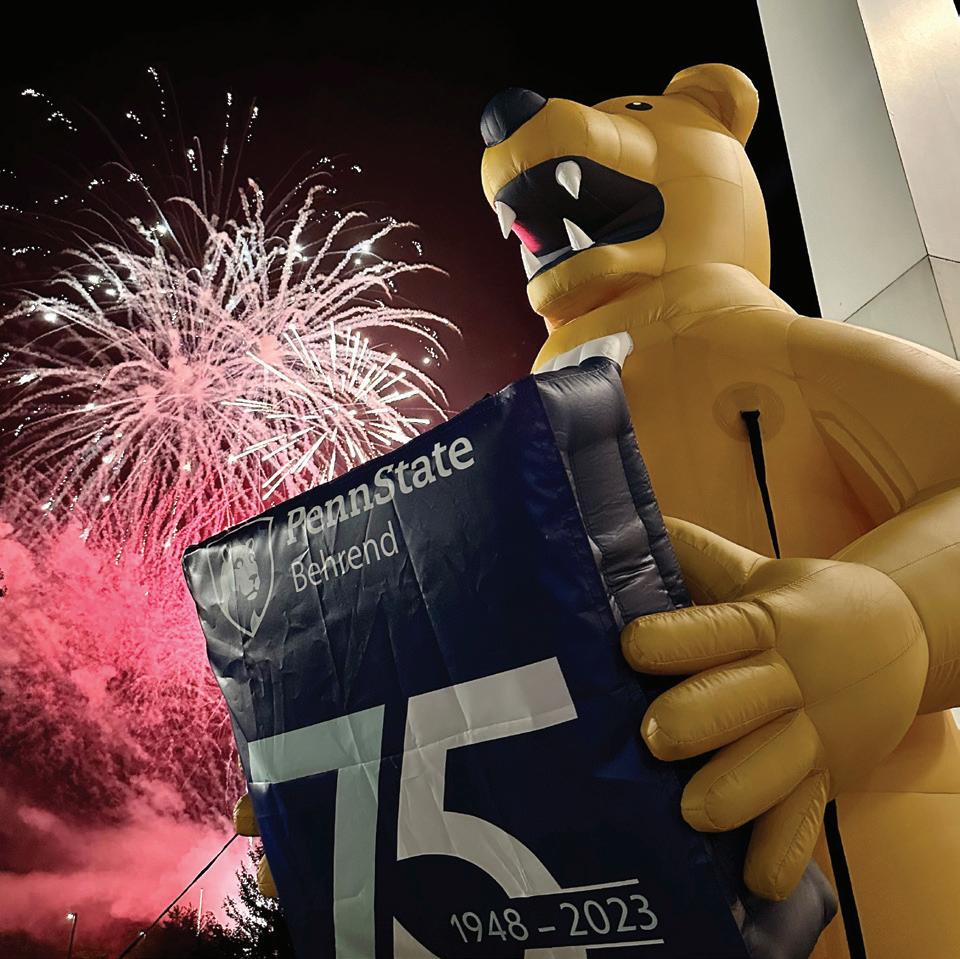
Faculty members who taught the first year at Behrend Center brought a focus on preparing students for success, on growing the college, and on meeting the needs of the community at the time. That focus has carried through the decades, shaping today’s academic portfolio of 100+ majors, minors, and certificates.
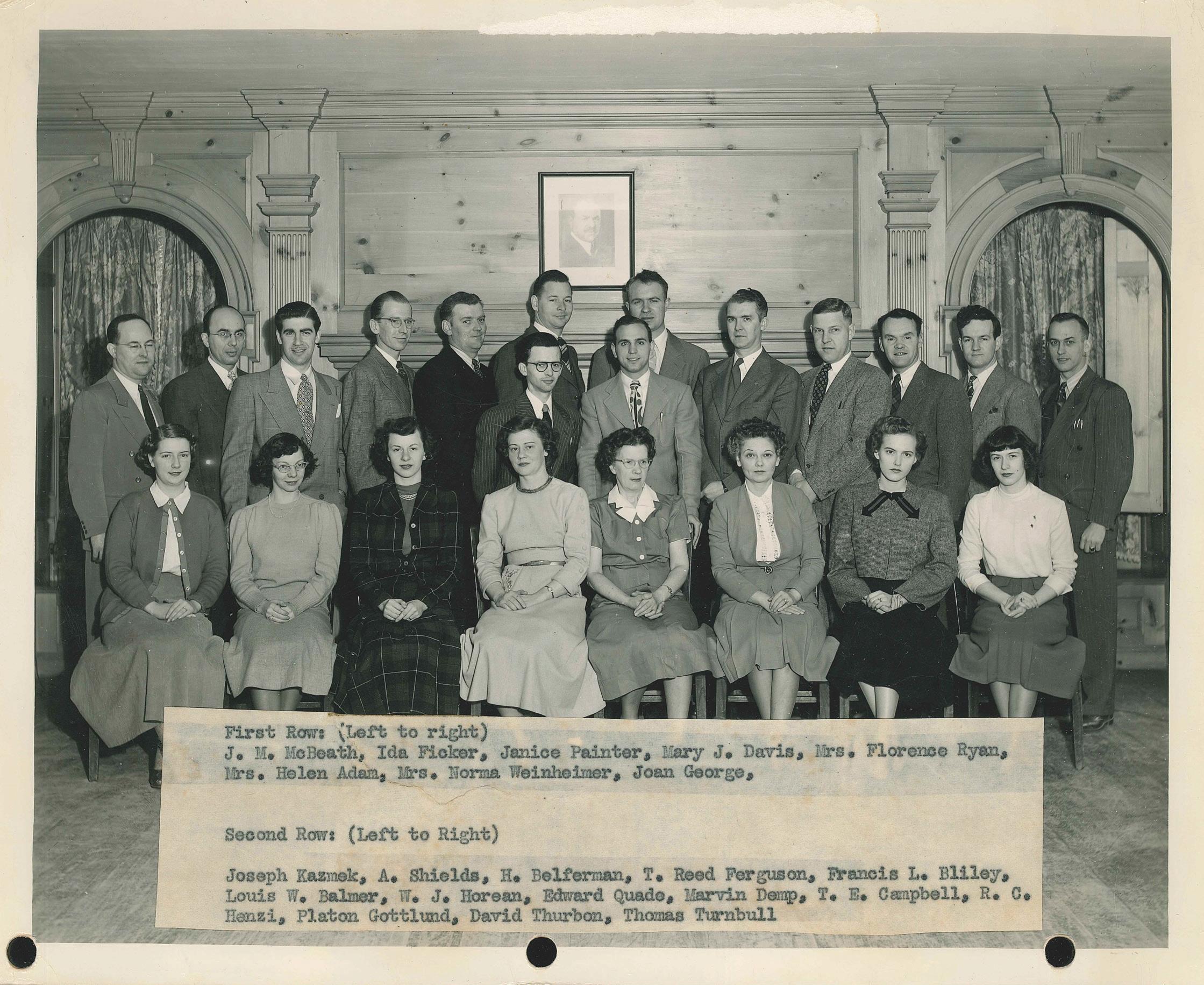

The faculty members who taught the first year at the Behrend Center in 1948 could probably never have imagined a major by the name of Functional Data Analytics. It’s also likely they could never have conceived of an online platform like World Campus, where that new Behrend major launched this past fall ahead of being offered as a residential program.
Those early teachers can, of course, be forgiven for not seeing into the future—for not envisioning the massive changes in business and industry, technology, and society in general that would influence academic programming at Penn State Behrend over the next seventy-five years.
What they did bring, though, was a focus on preparing students for success, on growing the college, and on meeting the needs of the community at the time. That focus has carried through the decades, shaping today’s academic portfolio of 100+ majors, minors, and certificates.
“From the history of Penn State Behrend over the past seventy-five years, you get a strong sense of the intentionality with which new programs have been developed,” said Dr. Greg Filbeck, interim vice chancellor and associate dean for academic affairs at Behrend. “There’s a record of our introducing programs expected to have enduring value in the marketplace and society.”
In the early days of the Behrend Center, all students began their studies in Erie, then transferred to State College to complete their degrees. Today, nearly seventy-five percent of students start and finish their University degrees at Penn State Behrend. From twelve subjects taught that first year, the college’s online course schedule now lists just over 670 courses, covering more than 100 subjects.
The first degrees to be offered at the Behrend Center—electrical engineering technology and drafting and design technology—came in the early 1950s in response to market demands for associate engineers; upon graduation, those engineers were heavily recruited by companies across the country. Within a few years’ time, other associate degrees were offered in business, nursing, the liberal arts, and mechanical engineering.
In 1971, Behrend became the first location outside University Park to develop bachelor’s degree programs and confer degrees locally. The first four-year degrees were in science and general arts and sciences, which encompassed the humanities, fine arts, social sciences, and natural sciences. In 1973, the Behrend Center was granted four-year and graduate degree status, becoming The Behrend College.
“So it happens that we are celebrating two milestones this academic year,” Filbeck said, “both our 75th anniversary of becoming a Penn State campus and our 50th anniversary of becoming an academic college of the university.”
By the early 1980s, with enrollment approaching 2,000 students, Behrend offered nearly twenty associate and bachelor’s degrees. The roster included several degrees that continue to the present, such as Accounting, Economics, English, History, and Political Science. Others would be introduced over the next twenty years or so in response to industry trends, technological advances, changes in employee skill sets, and globalization, among other factors. This would include new majors in Computer Engineering, Management Information Systems, Marketing, and Plastics Engineering Technology.
Behrend’s plastics program is the classic example of a major that grew out of an identified need. In the 1980s, a consortium of regional plastics manufacturers, led by company owners Joe Prischak and Paul C. “Hoop” Roche, approached the college about establishing a four-year degree in plastics. Together, they contributed more than $4 million to launch the program and fund construction in the early 1990s of the buildings to be known as the Engineering Complex (now known as the Science Complex).
The complex was the third major building project to occur on campus in the 1990s, following an academic building known today as Kochel Center and John M. Lilley Library. The growth in infrastructure was necessary to support enrollment that would surpass 3,200 as the year 2000 approached. By 2003, Behrend had nearly thirty-five undergraduate and graduate degrees.
Today, Penn State Behrend offers nearly 50 undergraduate and graduate degrees to students enrolled on campus and online through World Campus. That includes eleven Penn State degrees offered only by Behrend, including Creative Writing; Digital Media Arts and Technology; Interdisciplinary Business with Engineering Studies; Interdisciplinary Science and Business; and a highly popular Master of Project Management degree offered exclusively online.
The academic roadmap ahead calls for continuous assessment and refinement of existing programs; exploring new programs that demonstrate high labor demand; a focus on interdisciplinary offerings, which Filbeck describes as a strength of the college; and collaborating on the delivery of coursework through platforms such as the University’s Digital Learning Cooperative.
“Maintaining a strong academic portfolio is a defining feature of Penn State Behrend,” Filbeck said. “For the future, as in the past, that will require constantly evaluating and evolving to meet the educational needs of the times.”
The Behrend Center opens with 146 students taught by twelve faculty members. The first to register is Dorothy Holmstrom, an engineering student from Pittsburgh.
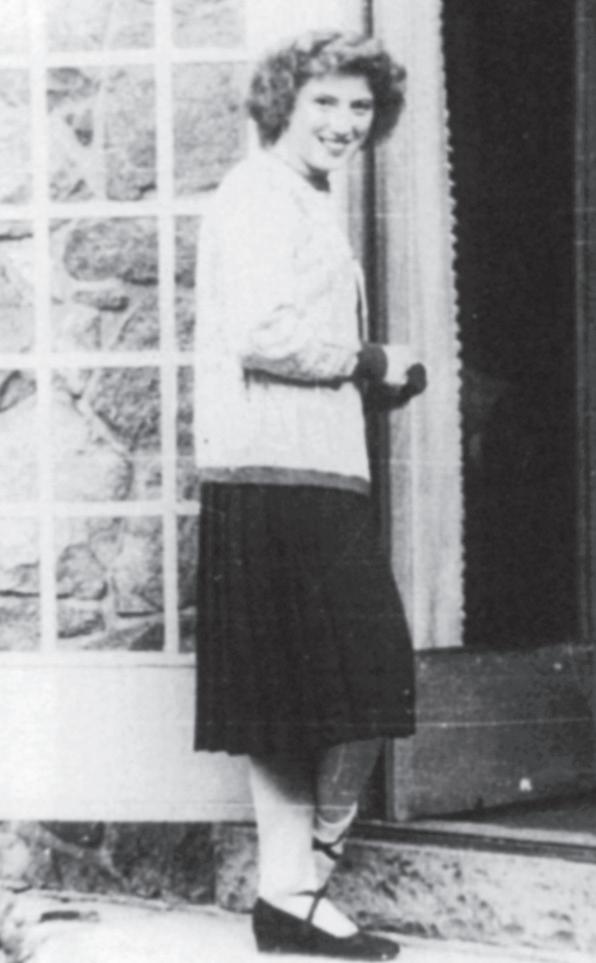
1 9 6 3
Otto Behrend Science Building opens, allowing for expanded science and engineering curricula. Enrollment is just over 300 students.
1953
Behrend begins offering two associate degrees—in Electrical Engineering Technology and Drafting and Design Technology—that can be completed at the campus.
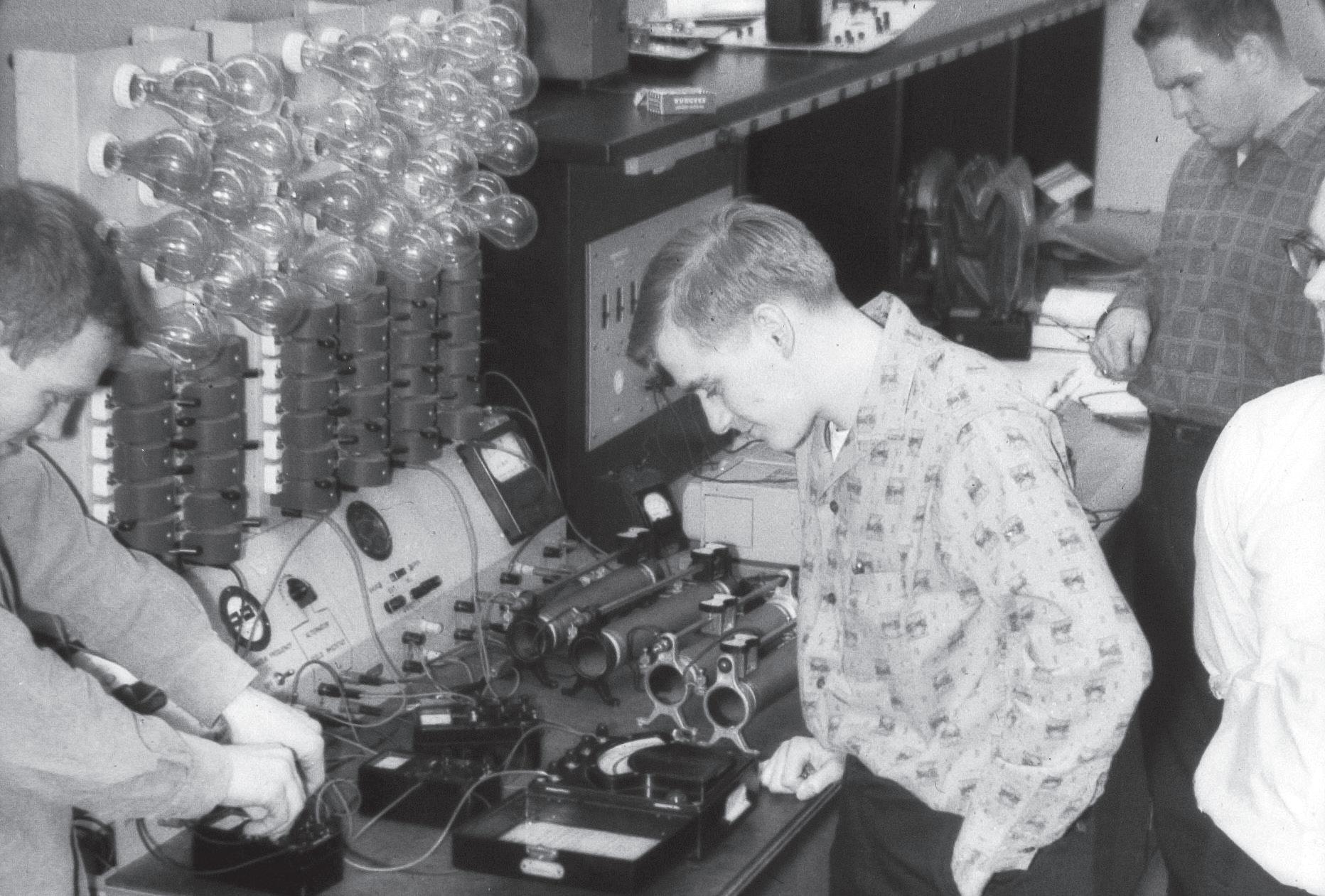
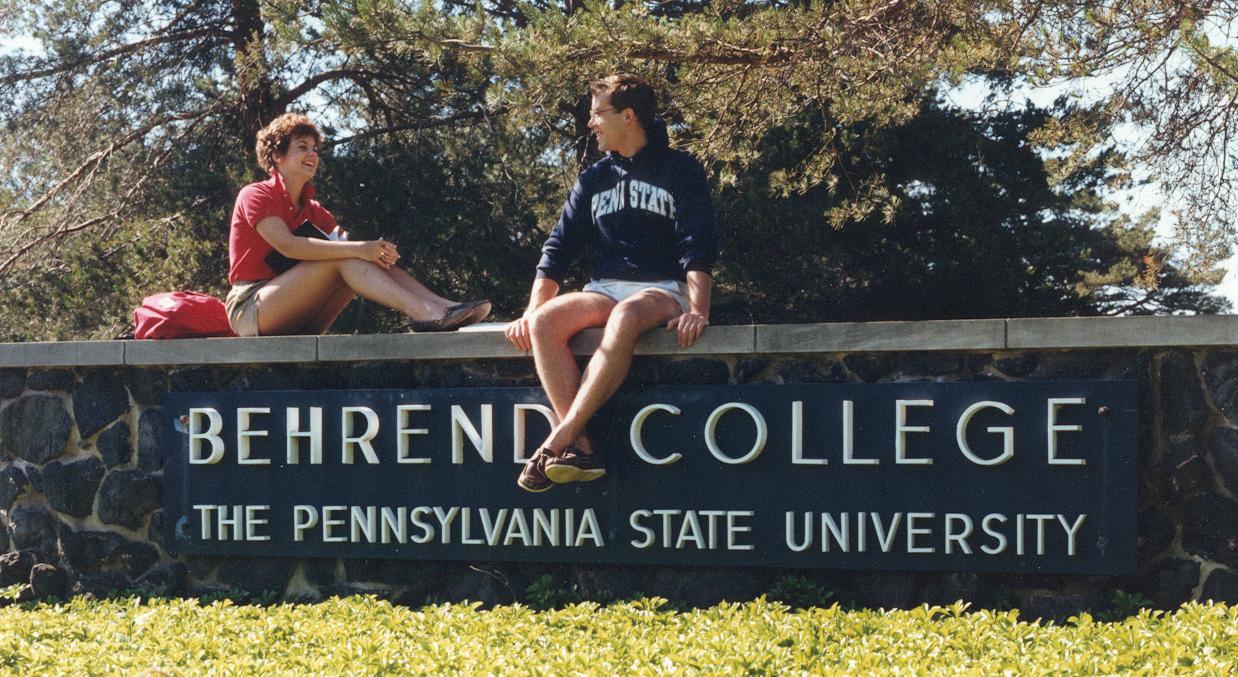
1973
The Behrend Center becomes The Behrend College, the first—and, for twenty-four years, the only—four-year academic college of Penn State located outside University Park.
The college offers fourteen bachelor’s degrees, including a number still offered today such as Accounting, Economics, English, History, and Math. Enrollment stands at 1,850 students.
Enrollment surpasses 3,200 students with recently constructed academic and library facilities to accommodate the growth.


More than 4,000 students are enrolled on campus and online. The college offers more than thirty-five undergraduate and graduate degree programs and access to hundreds of other Penn State degrees.
The college’s academic roadmap focuses on continuously assessing existing programs, exploring new in-demand programs, and emphasizing interdisciplinary programs and alternative delivery platforms.
Former math professor’s hobby produced one of Behrend’s greatest gifts.
Though he taught generations of college students during his thirty-seven years as a mathematics professor at Behrend, Norman B. “Bill” Patterson established a legacy that goes far beyond linear algebra, differential equations, and statistics. When he retired in 1990, he left a trove of photos documenting life at Behrend with intimacy and affection.
The camera he used to record much of it—a $129 model he saved all year to buy from Erie’s Boston Store in 1954—is in the archives at Lilley Library along with hundreds of his photos, a true gift to the college.
“If a picture paints a thousand words, Bill’s photos are surely the most expensive materials in the Behrend Archives,” said Jane Ingold, reference and instruction librarian and archivist at Behrend. “My ability to answer the many calls for photos for anniversary exhibits and stories like this one would be severely limited without them.”
In honor of Behrend’s 75th anniversary, a sampling of Patterson’s work was on exhibit in Kochel Center this past fall. “Behrend Begins: The Campus Photography of Norman B. Patterson” highlighted some of his most evocative photos from the 1950s through the early 1970s.
The exhibit provided a fascinating look into the past, offering a visual record of how Behrend has grown and changed over time.
At 98 years old, Patterson, who resides in an Erie-area senior facility, is happy to talk about photography and Behrend with visitors. When asked what type of camera he liked to shoot with, he quipped, “anything I could get ahold of,” adding, “Some things you are just interested in from Day One, and I liked taking pictures.”
Patterson’s introduction to photography was in 1938 when his older brother brought a camera, and he became immediately fascinated with it. Much happened for Patterson in the next 15 years, including receiving an undergraduate degree in chemistry, serving a stint in the Army in World War II, and returning to graduate school to earn a mathematics degree courtesy of the GI Bill.
When he was offered a mathematics teaching position at the five-year-old Behrend Center in Erie, a place he had never been, he took the job. “I said, ‘Well, I have nothing in mind at the moment, so why not?’” Patterson recalled.
When he arrived, no science buildings yet existed. The library was in what is now the Studio Theatre, and Turnbull Hall had been converted from the Behrend family’s horse barn into academic space. On his first day, the original Erie Hall opened.

He quickly fell for the campus and the city. “I liked Behrend, and I love Erie,” he said. “We have it all here.”
As was customary in higher education then, faculty members were heavily involved in the life of the campus and its students. There were few administrators and staff members. It was faculty members who helped with student clubs, activities, and events.
“I was up there at the college for events and things three, four nights a week,” he said. “And if you saw me, my camera would be right next to me. I took it with me everywhere I went.”
And he recorded history as it happened —one Winter Snowball dance, Hanging of the Greens, and Student Work Day at a time. He also photographed the daily college life that so fascinates today—the “lunch ladies” making food in the Glenhill Farmhouse kitchen, students cannonballing into the pool and skiing down the hill behind today’s Science Complex, and the female students
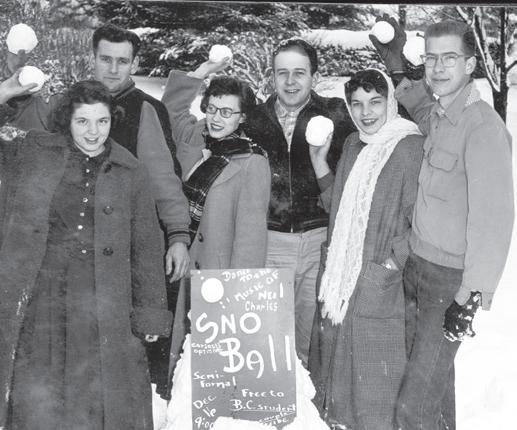



who lived on the second floor of the farmhouse, with bunkbeds stacked in each room.
When night fell, he developed the photos. “I didn’t have a darkroom, so I just had to wait until it got dark,” he said.
Later, he added a home darkroom in a corner of his basement. His son, Bob Patterson, a lecturer in accounting at Behrend, said that when he and his two sisters were growing up, they knew better than to flip on the basement lights without asking and risk ruining their dad’s work.
By the time Patterson retired, he had witnessed—and captured in photos—the remarkable growth of Penn State Behrend over nearly four decades. And, yet, he has a fondness for the earlier, leaner years.
“The lack of resources in the 1950s meant that you had to make do with what you had,” he said. “We didn’t have people to
“Some things you are just interested in from Day One, and I liked taking pictures.”
—Norman B. “Bill” Patterson Former Professor of Mathematics

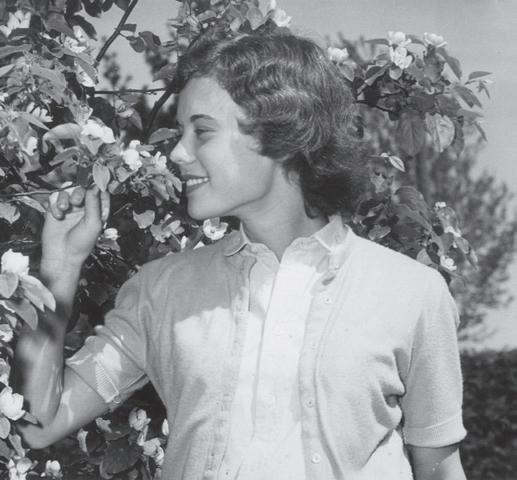
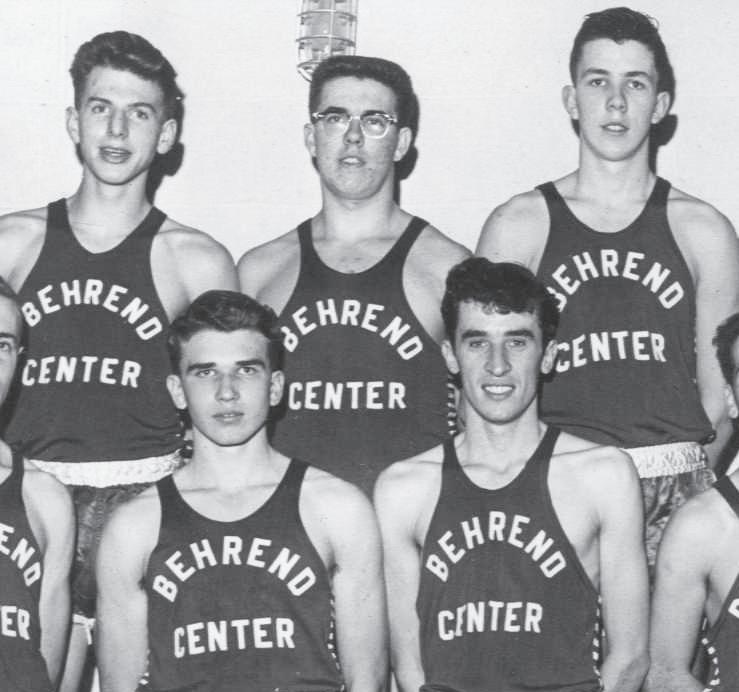

do the auxiliary, non-teaching work, so the faculty were much more involved in student activities and things.”
And, of course, Patterson, who was never without his camera, was there to document it all, and in retirement, he continued to enjoy photography, even mastering photo editing software programs.
“When dad retired, he got a computer,” Bob Patterson said. “I went over to help him set it up and he was the best student I ever taught. It wasn’t long before he was editing and restoring photos and turning them into 3-D images. ”
To further cement Patterson’s legacy at Behrend, a third generation of his family now works at the college: Granddaughter Katie Patterson, Bob’s daughter, who serves as an admissions counselor.
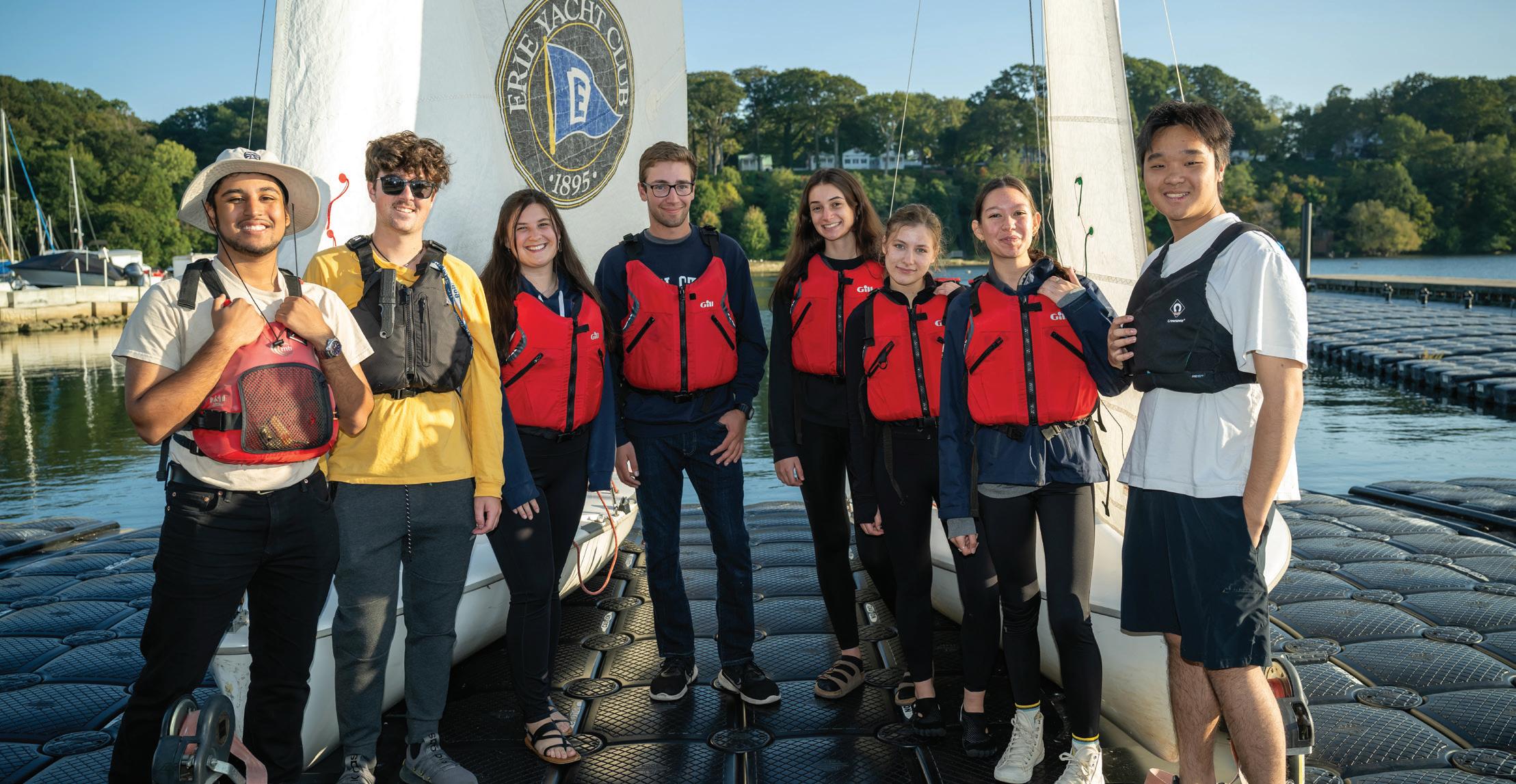
Hailey Rupp, a junior dual majoring in Marketing and International Business, grew up in North East, Pennsylvania, where Lake Erie was just a familiar, hometown backdrop. Great Lake. Beautiful sunsets. Yawn. Ho hum.
She may have always felt that way about the lake had she not had the opportunity to see it from another vantage point—the inside of an International 420 Dinghy, a two-person performance racing sailboat—as a member of Penn State Behrend’s Sailing Club.
“I gained a whole new perspective on the lake,” she said. “And it’s nice to enjoy the water that is so nearby.”
Rupp had never sailed nor spent much time on the lake when she attended a club showcase event at Behrend and met members of the sailing club, including Maryland natives and lifelong sailors
Bryce Nill, a Mechanical Engineering major; Chandler DeBarros, a Business Economics major; and Anthony Farrar, an Industrial Engineering major who grew up in nearby Fairview sailing on Lake Erie. Rupp went to a practice to check it out and decided to join the team.
The sailing club, which includes about a dozen members, has a mix of sailing talent and a boatload of enthusiasm for the sport.
“Our club members range from highly experienced racers and sailors, like Bryce, Chandler, and Anthony, to novices who are just learning to sail,” said Dr. Sharon Dale, professor emerita of art history, who, along with her husband, Alec, coaches the team. “There are two students in every boat, so we pair an experienced sailor with a novice so they can learn the ropes.”
And there are plenty of ropes to learn. Sailing is all about reading the wind, and adjusting the sails, by tightening
or easing; turning the boat, by gybing (going with the wind) and tacking (going into the wind); and using the vessel’s rigging and the sailors’ bodyweight to gain advantage.
“We start with the basics, how wind works, how the sails react,” said Nill, who worked as a youth sailing instructor in his home waters of Deep Creek Lake in Maryland. “If I can teach a six-year-old to sail, I can teach a college student to sail. The foundation is simple, but it does get complicated. Physics and geometry come into play.”
The 420 boats the students race are surprisingly small. The name refers to the boats’ length of 420 centimeters (13 feet, 9 inches). Sailors can, and do, tip over and “roll” their vessels. It’s part of the sport, and something the team practices routinely.
While doing a somersault on a tiny sailboat in Lake Erie might seem the most terrifying aspect of sailing, Rupp,

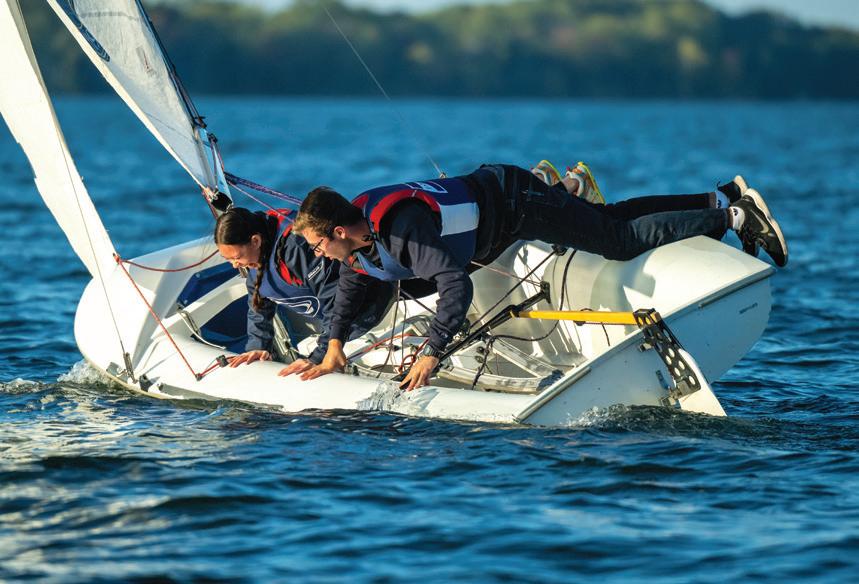
and teammate Sara Trunzo, who was also a novice when she joined the team in 2022, say there is something they fear much more: spiders.
“They’re awful,” Trunzo said with a shiver. “They are all over the sails and ropes. I’d much rather fall in the lake than deal with the spiders. It’s just water.”
Both Rupp and Trunzo said that sailing wasn’t difficult to learn and isn’t physically hard to do, though it took some time to learn the lingo and master rigging the boat and turning the sails.
“I liked being able to learn something completely new,” said Trunzo, an Accounting major and Brockway, Pennsylvania, native. “And being on the lake is peaceful and it’s really beautiful.”
The students practice at the Erie Yacht Club using the club’s boats, and they receive generous financial support from the Erie Yacht Club Foundation. Funds are used to purchase gear, such as dry suits and Penn State shirts, and to cover
The Behrend Sailing Club is a member of the Middle Atlantic Intercollegiate Sailing Association (MAISA) and the Inter-Collegiate Sailing Association (ICSA), a national group to which all competing college teams belong.
travel and race entry expenses.
The investment has paid off: Behrend’s sailing club does well in competition, regularly beating clubs from powerhouse institutions, such as the University of Pittsburgh, Penn State, Syracuse University, Rochester Institute of Technology, the U.S. Army West Point Sailing Team, and the University of Toronto.
At the club’s home meet—The Battle of Lake Erie—held this fall at the Yacht Club, they took third place. They finished their season strong, winning the Delaware Spring Open by defeating teams from Drexel, Rutgers, Villanova, and the U.S. Military Academy.
“Life doesn’t get much better than sailing and winning, and that is what we do,” Dale said. “Being on a sailboat with the right wind on a sunny day is magical, and we would love to share that magic with more Behrend students.”
Follow the team at instagram.com/ psb_sailingclub.

Bryce Nill grew up sailing on Deep Creek Lake in Maryland, where he got to know Carrie and Tyler Andrews, the owners of Flying Scot, a company that specializes in handmade, crafted sail boats Last summer, the company offered to sponsor Nill in the Flying Scot Junior North American Championship in Westport, Connecticut, where Nill and his sailing partner ultimately took second place.
Nill came back to Behrend with something even more valuable than a trophy – a project for the James R. Meehl Innovation Commons, the college’s product development and prototyping center, where students work with innovators and entrepreneurs.
“I rode to the competition with Tyler and he told me that they were experiencing supply chain issues so I recommended they start 3D printing some of their parts,” Nill said. “The company took my advice and bought a 3D printer. I have been working with Tyler and Carrie through Innovations Commons, modeling the parts for them and emailing them to the company to print. They built their first boat with my parts in December.”



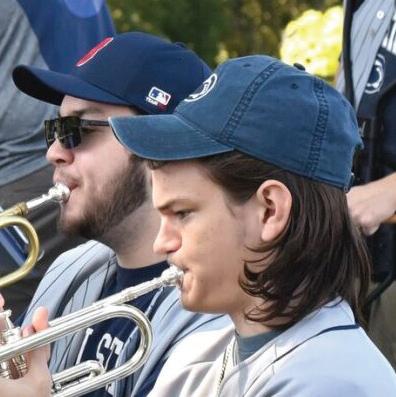


In a world that can feel deeply divided, there is one thing that every culture on every continent has in common—music.
“It’s like magic,” said Jim Dowds, case manager in Penn State Behrend’s Personal Counseling Center. “Music has been found in some form in every nation throughout history. Singing. Dancing. Drumming. It’s all musical.”
This universal appreciation of music, in whatever form it takes, helps us connect—with others and with ourselves.
“From listening to dancing to playing an instrument, the deeper you get involved in music, the more that it can help you,” said Dowds, who plays drums for The Groove, a popular Erie dance band, in his free time.
Dowds often encourages students to pursue musical hobbies as a form of stress relief.
“College is hard, and students need a place to escape, to be creative, to play, and to have fun,” he said. “And getting involved in some form of music is a good way to find friends who share your interests.”
Fortunately, students at Behrend who want to scratch that musical itch have a lot of options.
“Students can perform in our ensembles, which include concert band, pep band, jazz ensemble, and choir,” said Dr. Joel Hunt, associate teaching professor of music. “They can take courses on a variety of music topics, such as electronic music, jazz history, music theory, The Beatles, and music production.
They can even complete a Music Technology minor.”
A professional saxophone player, Hunt also plays drums, guitar, piano, flute, and clarinet, and is currently learning the oboe. He is also immersed in the digital musical genre as well, playing modular synthesizers and composing interactive computer music.
“I’ve been evenly split between electronic and acoustic music worlds,” he said. “I teach electronic music production and the history of electronic music, but I also teach music theory and jazz history. It’s all the same to me.”
In addition to courses and programs, Behrend offers further opportunities to engage with music, including musical theatre, a drumline club, an a capella club, and a club that creates and presents electronic musical concerts on campus.
And, for those who may not want to commit to a group or club, Behrend’s Personal Counseling Office offers weekly drop-in drum circles and sound meditations to promote improved mental health and wellness through music. (For schedules, students can follow the office on instagram.com/ psbcounseling.)
“Musical activities are more than a creative or artistic outlet,” said Dr. Gary Viebranz, teaching professor of music and director of instrumental ensembles. “Students in our musical groups have a valuable resource in the other members who can answer a lot of questions, help them navigate college, and provide friendship.”
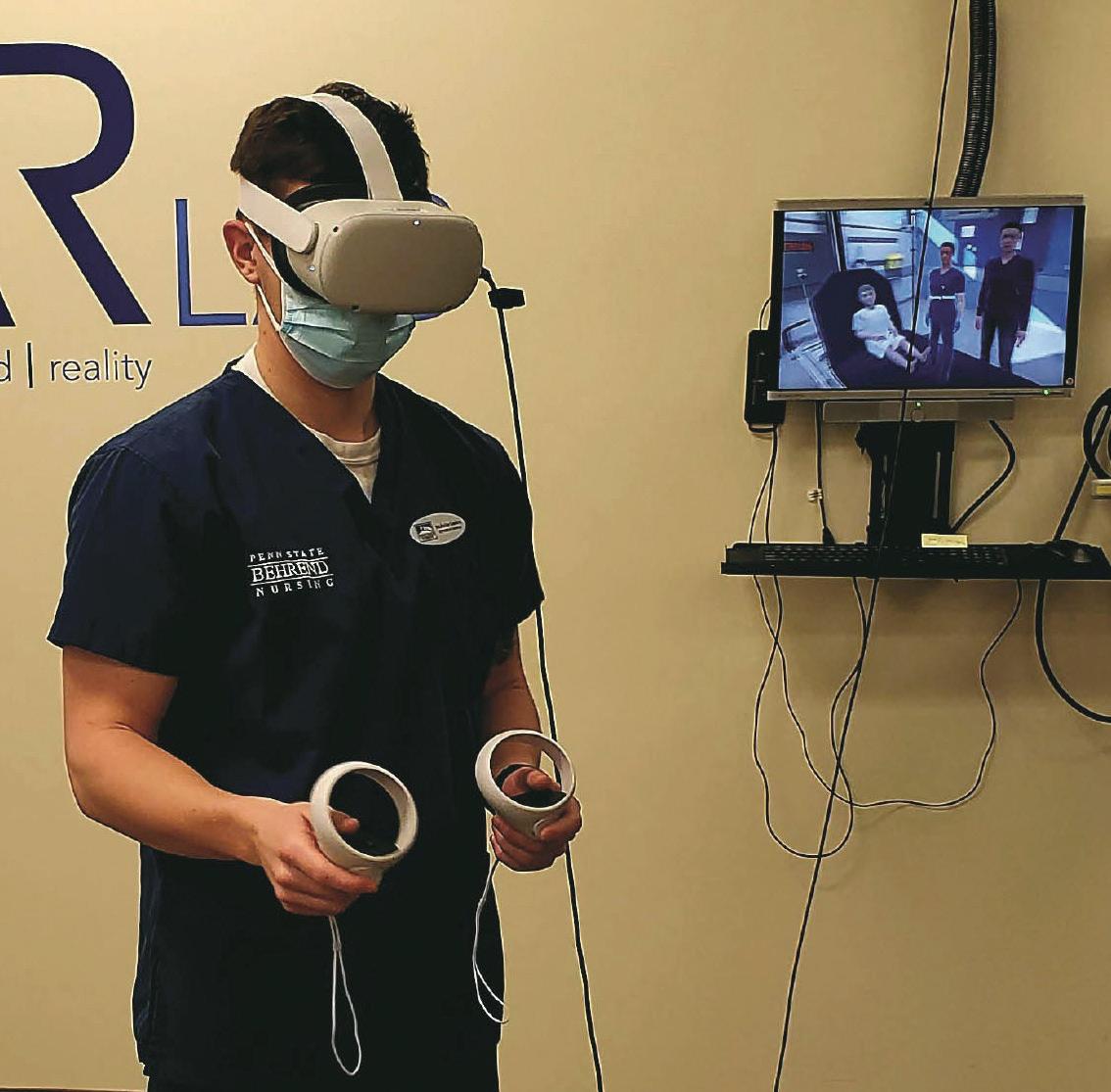
far for the other equipment, including the Oculus headsets used to create the immersive VR environments: Behrend’s Virtual/Augmented Reality (VAR) Lab works with programs in the college’s four academic schools to develop enhanced learning modules and training simulations.
“Immersive technologies have extensive interdisciplinary applications and proven benefits in academic outcomes,” said Dr. Christopher Shelton, assistant professor of clinical psychology and director of the VAR Lab. “This project is an effective way to leverage VR inside the classroom.”
Using the Oculus headsets and hand controls, the students worked through twenty-minute VR modules simulating the care of pediatric patients with asthma and diabetic ketoacidosis. They obtained a patient history, performed assessments, managed bedside tasks, and delegated work to a patient-care technician.
linical rotations are invaluable to nursing students, giving them real-world experience in a guided environment.
The model has limitations, however, particularly in acute care.
“Because of the acuity level of OB, ICU and ED patients, students don’t always have the opportunity to deliver direct patient care,” said Debra Loop, an assistant teaching professor of nursing and the simulation coordinator for the Nursing program at Penn State Behrend. “They quickly become passive learners as they take on the role of observer.”
Pediatrics brings another challenge for
Behrend students: The sickest local children tend to be transferred to specialty hospitals in Pittsburgh or Cleveland. That limits the types of patients that students see during their rotations.
To create more opportunities for students, Loop and Heidi Rich, assistant teaching professor of nursing, introduced patient simulations using virtual reality (VR). They partnered with instructors at Penn State Fayette–both programs being part of Penn State’s Ross and Carol Nese College of Nursing–to offer VR interactions.
A $5,000 grant from the Schreyer Institute for Teaching Excellence paid for the software, but Loop didn’t have to look
In each scenario, the student interacted with both the patient and the parents. That isn’t always possible in Behrend’s advanced nursing labs, which are equipped with high-fidelity simulation mannequins, including a pediatric model. In those labs, having a parent present means bringing in additional staff to enhance the simulation.
“We can’t always do that,” Loop said. “It’s important for students to be exposed to both, however. You need to be able to interact with the child and the parent, changing your vocabulary as you shift from one to the other, so everyone understands what’s happening.”
Traditional simulation is still fully integrated in the curriculum at Behrend, but Loop sees another advantage to using VR environments at times.
“In the traditional lab, only one person can be the primary caregiver in a simulation,” she said. “Everyone else sort of helps them out until they get a turn. In VR, you are always the primary nurse.
“In a group setting, you can always step back and let another student take over,” she said. “You can’t do that when you’re on your own. You have to make your own decisions, and you have to fully understand the reasons for those decisions.”
‘Studying abroad was the most amazing thing I have ever done.’
Behrend student says semester-long experience in France was life-changing.


One thing Sophia DiPlacido knew for sure when she started at Penn State Behrend is that she wanted to leave—for at least a semester.
“I have always wanted to study abroad,” said DiPlacido, a junior dual majoring in Marketing and Psychology. “I was slightly worried about language barriers, though, so I looked at countries with residents who spoke English as a first or second language.”
She chose France and set off last January to spend the Spring 2023 semester in Aix-en-Provence, known as “Little Paris.” She lived with a host family in a home with three other students from U.S. universities who were also studying abroad.
“My host mother had done a study abroad experience, so she wanted to help others have that opportunity,” DiPlacido said.
She took five classes—International Business, French, History of Christianity, Wine Marketing, and Drawing and Painting—at the Institute for American Universities, where DiPlacido said curriculum is king.
“Extracurricular activities are not a thing in European universities,” she said. “College in France is actually closer to what I had been told in high school that college would be like, which is to say that instructors would not be very accessible, the classes would be mostly lectures, and your grade would be made up of just a few exams.”
While her college experience was different from her experience at Behrend, DiPlacido said she felt at home in France.
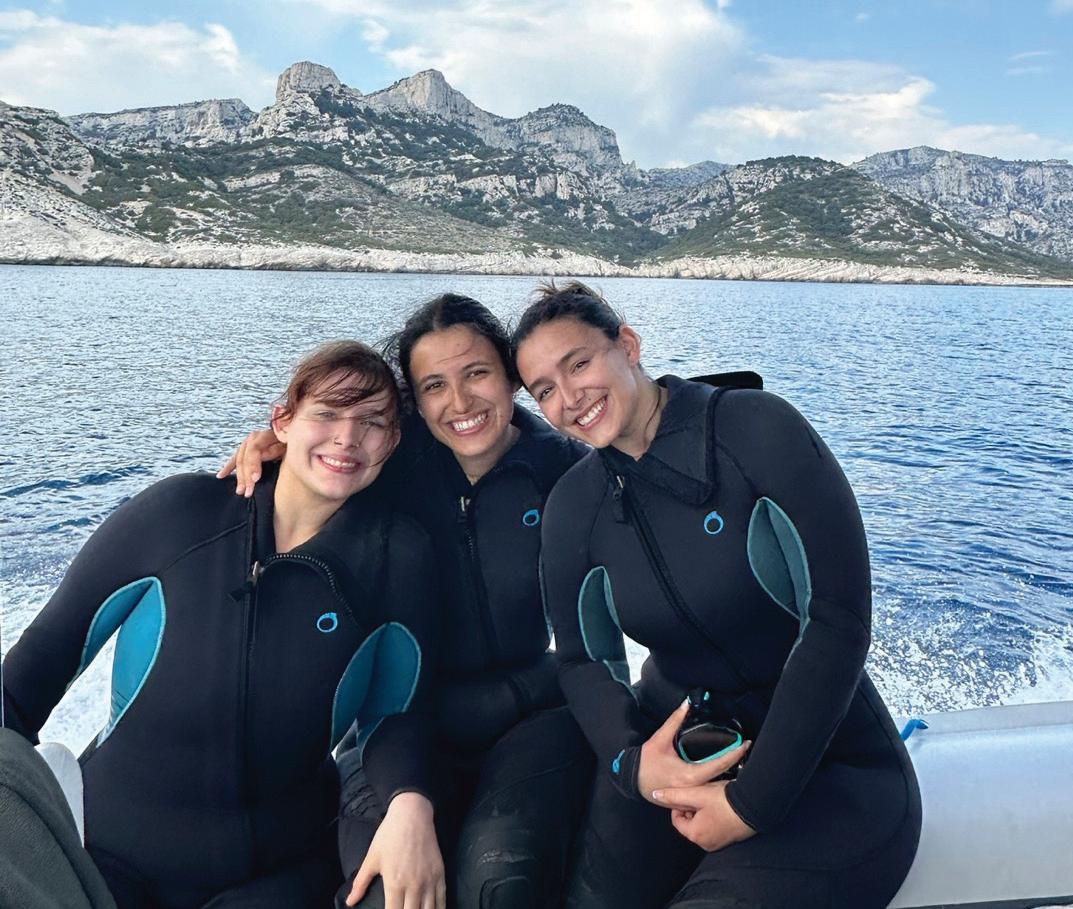
“I easily adjusted,” she said. “The geography reminded me of California, and the people were very welcoming. I expected to encounter some resistance because I didn’t speak their language, but everyone was nice about it.”
She didn’t have classes on Fridays, so she was able to explore nearby countries as travel throughout western Europe is relatively easy and inexpensive. Among her many adventures: visiting the Eiffel Tower in Paris; skydiving in Switzerland; scuba diving in Marseille; making pasta in a cooking class in Venice; and seeing the Cliffs of Moher in Ireland. She also visited Budapest, Brussels, London, Madrid, Nice, and Prague as well as cities in Germany and Luxembourg.
DiPlacido said that all that travel helped her develop important life skills. “I didn’t have a strong sense of direction,” she said, “but I developed it getting around on my own. It gave me a lot of self-confidence.”
DiPlacido said she would recommend a study abroad experience to students in any major but cautions that it takes work to prepare for it, even with guidance from Behrend’s Learning Resource Center, the campus experts on global programs.
“You have to be proactive and get your visa and passport and stay on top of what needs to be done when,” she said. “But in that responsibility is personal growth. Studying abroad was the most amazing thing I have ever done. You come back a whole different person with an entirely new perspective on the world.”
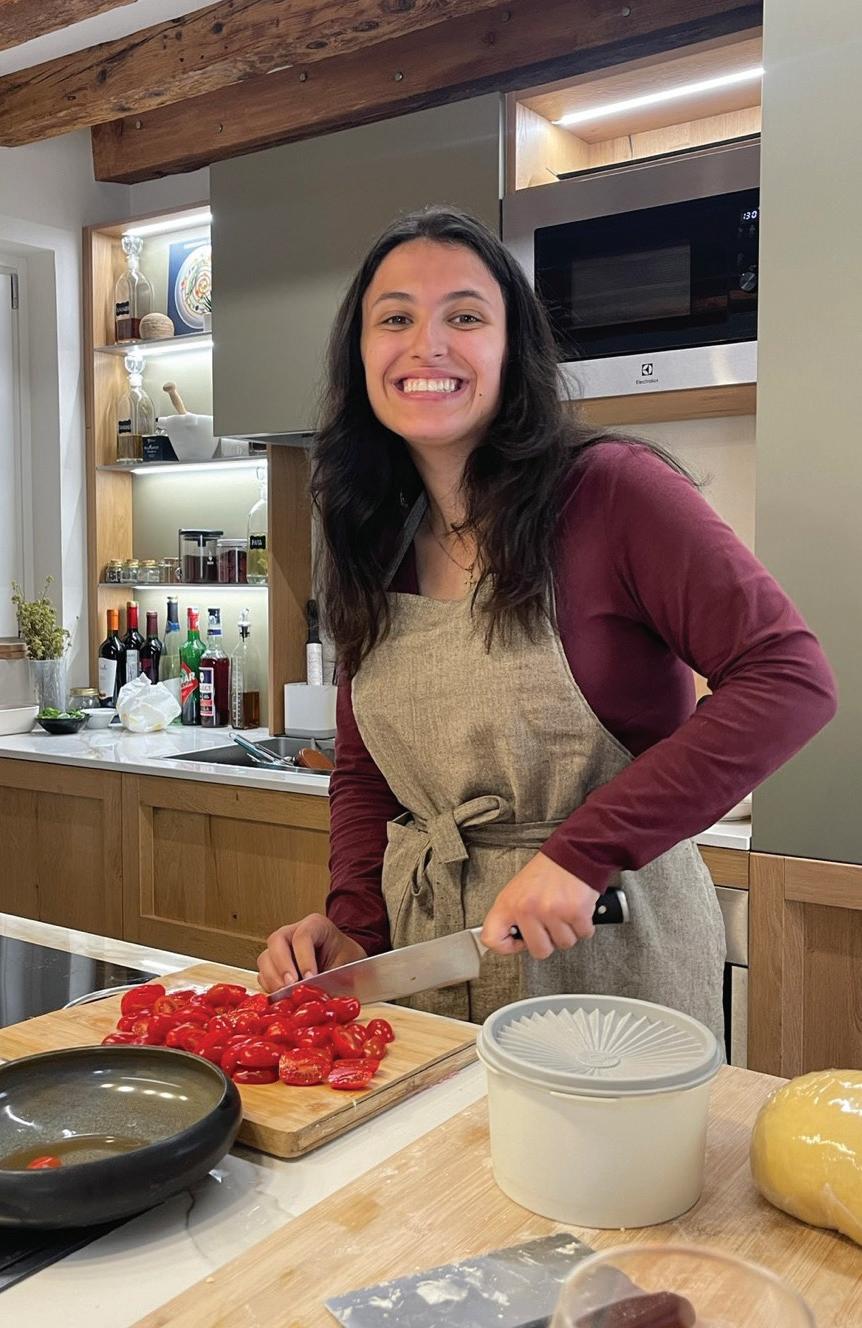
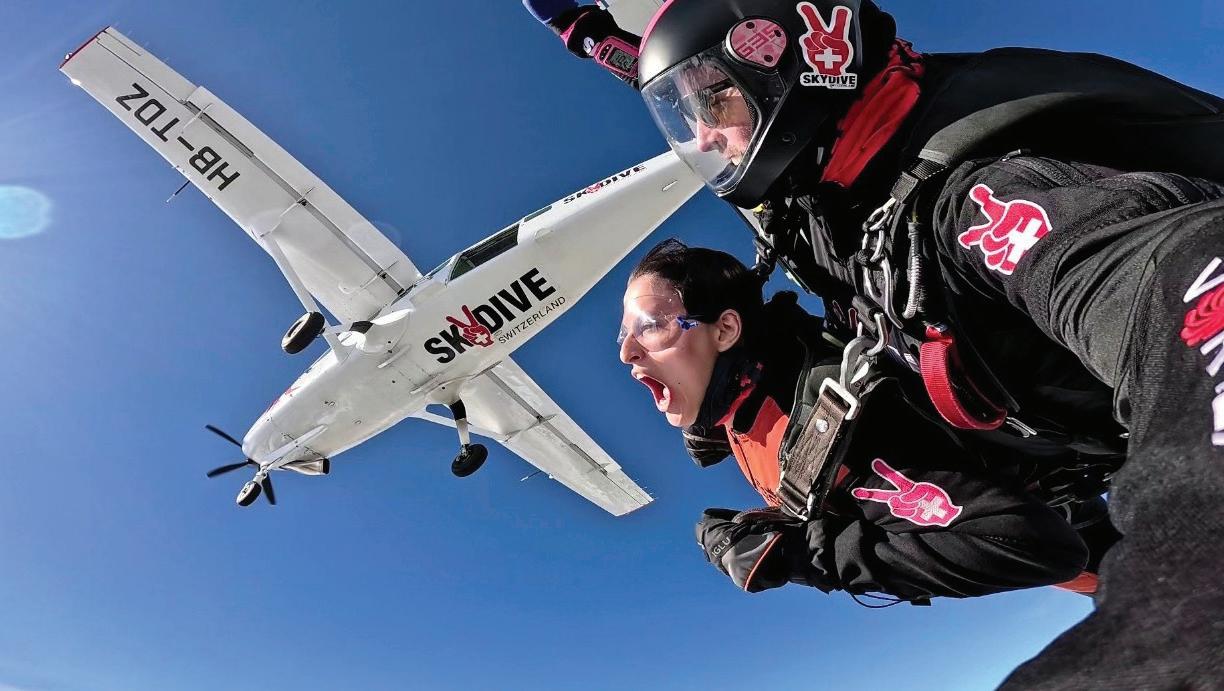
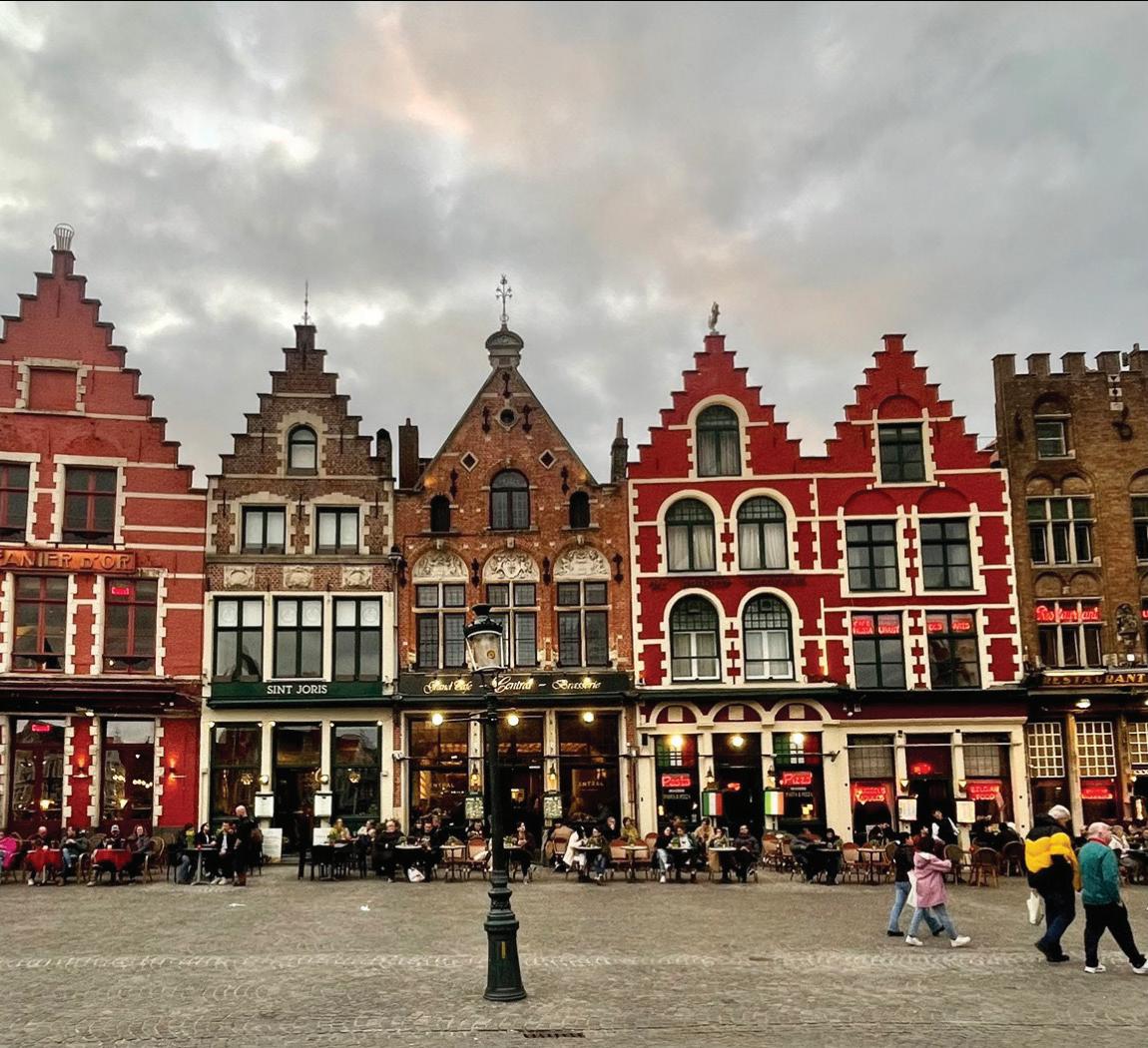
No, at Behrend, the international study experience can be as short as ten days or as long as a full academic year, depending on the type of program a student selects. International study programs happen throughout the year—during fall and spring semesters, at semester breaks, and over the summer.
Do you need to speak a second language?
No, but you do have to be a strong student, academically, to be eligible for international study. The minimum grade point average is a 2.5, and many programs require a 3.0. Prerequisites vary by program.
Cost varies depending on the program and location, but you can expect to pay tuition, travel expenses, and for meals and personal expenses while abroad.
Scholarship funds are available for those who qualify. DiPlacido received funding from Penn State Behrend’s Study Abroad program and the University’s Schreyer Honors College, and she won a competitive Gilman Scholarship, administered by the U.S. Department of State.
Attend one of the study abroad information sessions that are held weekly at Behrend every semester. A list of upcoming sessions is available at behrend.psu.edu/studyabroad, where students can also learn about the different types of programs; explore upcoming opportunities; and find out about the application process and deadlines, as well as financial aid and scholarships.
For more information contact the Learning Resource Center by email at bdlrc@psu.edu or call 814-898-6140.
In search of community, discus thrower finds success.

When Dan Dabrowski graduated from Harbor Creek High School in 2020, he had no intention of joining Penn State Behrend’s track and field team. In fact, he didn’t plan to attend Behrend at all and instead was headed for University Park—until COVID-19 changed things.
Like many students in the early part of the pandemic, Dabrowski struggled to make connections when everyone was masked and gathering was not permitted. But he was determined to make the most of his college experience.
“I thought, if I’m going to be here, I have to find a way to get involved and make the best of the situation,” he said.
He was a standout swimmer in high school, but a shoulder injury prompted Dabrowski to pursue Option B in college:
track and field. He joined the team as a walk-on thrower.
“When he contacted me about joining, he didn’t have standout marks, but he was taking time to really focus on discus while the world was shut down,” said Greg Cooper, head track and field coach. “He sent a video of himself throwing, and that made me excited to get him on the team.”
“Discus Dan,” as he would soon become known, went all-in on throwing. He practiced for hours on end, perfecting his form and technique. He went to strength training daily. He filled his free time throwing during that first long, tedious year of the pandemic.
The foundation Dabrowski built led to his first appearance at the 2022 NCAA Division III national championships, where he finished eighth with a throw of 49.73
DID YOU KNOW: A DISCUS WEIGHS 4.4 POUNDS?
meters. Last year, he placed sixth in national competition with throw of 50.97 meters. He’s looking forward to this year’s outdoor season—his last—before he graduates in May with a degree in Finance and a minor in Applied Economics.
Behrend Magazine talked with Dabrowski about how his quest for connection led to such remarkable athletic achievement and about competing at the national level in discus.
What does it take to be a good discus thrower?
Strength and technique. Strength is built in the weightroom by lifting heavy and with a purpose. Technique is something you develop by throwing a lot, drilling outside of practice, and constantly reviewing your throw and trying to find the right body position. In discus, power comes from the legs and rotation of the
body. It’s not a natural movement, so you have to get comfortable with being uncomfortable.
Is there a secret to a good throw? No. It’s just being consistent and putting your time in at the weight room and in practice. You get out of it what you put into it. To improve, you need to become a student of the sport. I spent hours and hours studying discus and other throwers’ techniques.
What do you enjoy about it?
Of course, I love competing, but I find throwing in general to be calming and peaceful. I sometimes throw just for fun with no goals. And I like the team. When I started, the seniors were great and welcomed me and provided the community that I was looking for. Now, as a senior, I try to do the same for new teammates.
What do you wish people knew about student athletes?
Sometimes people think Division III athletes are inferior to athletes in higher divisions, but we work just as hard, are just as competitive. And, we’re expected to keep our grades up, and that doesn’t mean just passing.
What do you like to do outside of athletics?
I like to be with people and to stay busy, so I go to a lot of Behrend athletic games, attend School of Business events, and am active in Chi Alpha. I also work at Luden’s Financial Services in Lawrence Park.
What are your goals for this year’s outdoor season?
I just hope to keep improving, both in the circle and out of it. Of course, I’d like to go to nationals, which is in Myrtle Beach, South Carolina, this year.
Anything else you want to add?
I feel fortunate to have spent the last four years working with great coaches and student-athletes who have given me the knowledge, wisdom, and resources I needed to become the best I could be.
Two longtime Behrend head coaches—Dan Perritano, men’s soccer, and Jeff Barger, tennis—have announced their retirements.
Barger, who was the all-time winningest Behrend coach for both men’s and women’s tennis, retired in December. During his twenty-five-year coaching tenure, he won a combined twenty-two Allegheny Mountain Collegiate Conference (AMCC) Championships and was named Coach of the Year seventeen times.
Barger led the women’s tennis team to fourteen conference titles, including the most recent title in 2020. From 2004 to 2011, the team won seven straight championships. On the men’s side, Barger led the Lions to eight AMCC titles, including the last one in 2023.
After thirty-one seasons at the helm of the men’s soccer program, Perritano will retire in May. He began his coaching career at Behrend as the men’s soccer head coach in 1993. In 1995, he took on double-duty, also becoming the women’s soccer head coach.
During his nine years as the leader of the women’s program, Perritano tallied 109 victories, guiding the team to a 36-game winning streak to start the league with four consecutive AMCC titles (1997-2000). As the women’s coach, he

propelled the program to three ECAC bids and its first-ever appearance in the NCAA DIII Tournament, while leading the team to seven winning seasons.
Just before the 2004 season, Perritano stepped away as women’s soccer head coach to focus solely on the men’s program. During his tenure, the men’s soccer team earned ten conference titles, ten ECAC bids, eight NCAA DIII appearances, one ECAC Championship, and four AMCC regular season championships. He was named AMCC Coach of the Year three times.

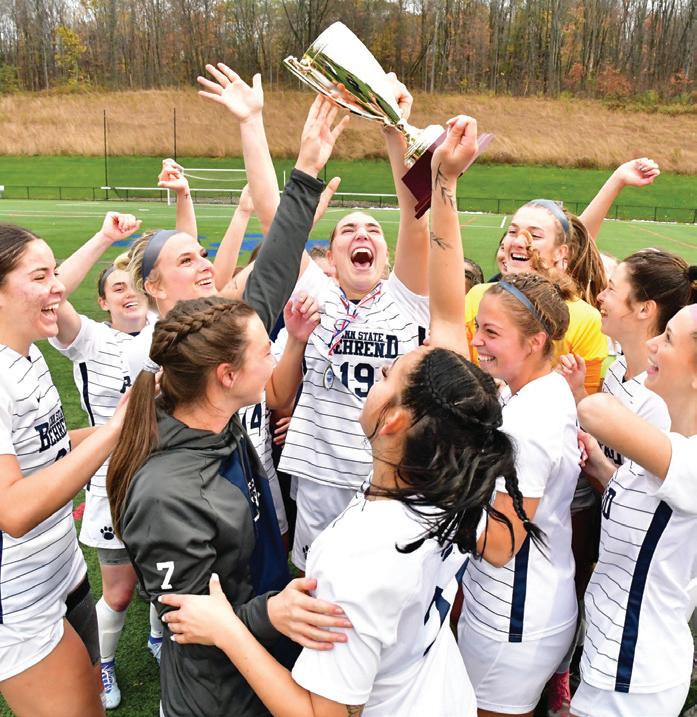
 By the Numbers
By the Numbers
All-Conference Athletes
f Cross-Country: 11 men, 5 women
f Men’s Soccer: 10
f Women’s Soccer: 9
f Women’s Tennis: 6
f Women’s Volleyball: 3
f Men’s Golf: 2
AMCC Runners Up
f Women’s Tennis
f Men’s Soccer
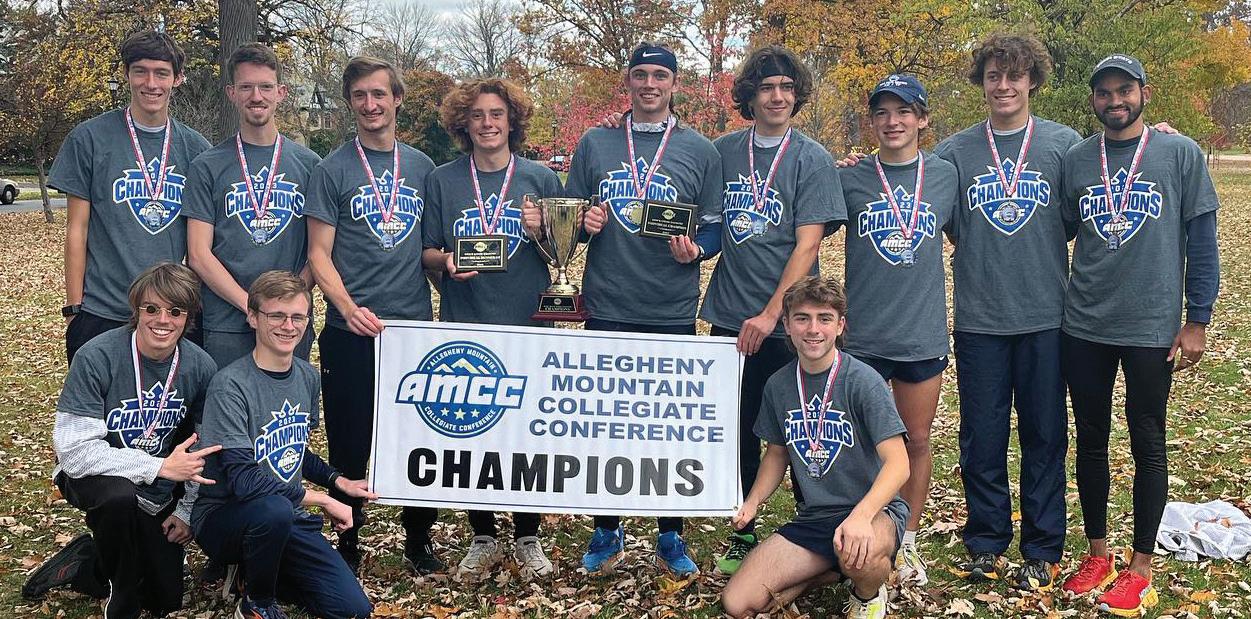
AMCC Champs—Women’s Cross-Country: The Penn State Behrend women’s cross-country team picked up its thirteenth—and fifth straight—overall AMCC Championship this season. Junior Olivia Nola won the AMCC individual title with a winning time of 23:10.76.4. Nola earned her second AMCC Runner of the Year accolade. Nola went on to place thirty-first at the NCAA Regional DIII Championships, earning All-Region honors.
AMCC Champs—Men’s Cross-Country: The men’s cross-country team won its fifteenth–and fourth straight—overall AMCC Championship title. Behrend had eight runners in the top ten, including the individual winner Kody Klein. Klein won the 8K race in 26:10.29 to be named the AMCC Runner of the Year for the second straight year. Klein finished the season at the NCAA DIII Regional Championships, placing twentysixth and earning a spot on the All-Region Team.
AMCC Champs—Women’s Soccer: Women’s soccer won its sixteenth overall AMCC Championship in 2023 and was named AMCC Regular Season Co-Champions with Pitt-Greensburg. Behrend tied Pitt-Greensburg in the championship game and defeated the Bobcats 3-0 in penalty kicks, advancing to the NCAA Tournament, where Behrend fell to Rochester. The Lions had nine players earn All-Conference. Three players were selected All-Region, while Trinity Prestash earned USC Scholar All-Region accolades. Kristi Buckenheimer and Rachel Sickeri also earned ECAC honors.
Runners of the Year: Olivia Nola, Kody Klein (cross-country)
Co-Defensive Player of the Year: Justin LeDonne (men’s soccer), Kristi Buckenheimer (women’s soccer)
Newcomer of the Year: Rachel Sickeri (women’s soccer), Tamanna Sharma (women’s tennis)
Coach of the Year: Greg Cooper (men’s and women’s cross-country), Patrick O’Driscoll (women’s soccer)
In 1949, when the Behrend Center set out to raise the $150,000 needed to build Erie Hall, it became a community effort. In the first day of fundraising, the campus raised more than $27,000. Support came from both individuals and local companies.
Once completed, Erie Hall quickly became a multi-use facility, housing classrooms, faculty and staff offices, a gymnasium, a stage, and a student lounge. For many years, it was the site of Behrend’s popular Snowball Dance, and the annual Homecoming Dance was the setting for at least one blind date that led to a decades-long marriage.
Clifton (Clif) Merchant ’58 was a firstyear student at Behrend before transferring to State College. In his second year, he came back to campus for homecoming weekend, including the dance in Erie Hall. His date for the evening, arranged by a friend, would become his wife of 58 years, the late Linda Hamer Merchant ’59.
Fast forward to 1981, when Diane Metzgar, a member of the women’s basketball team, was working in the equipment room and lent a basketball to Rich Doane. When he tried to return it later that day, she was already gone, so he sought her out that evening to return it to her, personally. That chance encounter
led to marriage for the 1985 graduates.
Reflecting on their memories of the original Erie Hall, the couple made a gift to support Behrend and the new Erie Hall fitness and recreation center. That’s the story behind the naming of the main thoroughfare in the new building: the Doane Family Lobby. The support of yet another family is also reflected in the naming of the John and Judith Cipriani Family Welcome Desk. John Cipriani is a 1958 graduate, as was his late wife, Judith. In the 1950s, he served as president of Behrend’s Student Government Association (SGA).
As the original Erie Hall was removed and the new Erie Hall was under construction, Behrend’s Development and Alumni Relations team heard from countless alumni who shared memories of that first facility built with community support.
If you have fond memories of the original Erie Hall, you might consider turning those memories into support for the new Erie Hall to benefit future generations of Behrend students. A member of Behrend’s Development team can talk with you about supporting the Erie Hall endowment, naming opportunities in the building, and other giving possibilities. Contact Britt Daehnke at bxd244@psu. edu or Dave Johnson at dbj6@psu.edu.
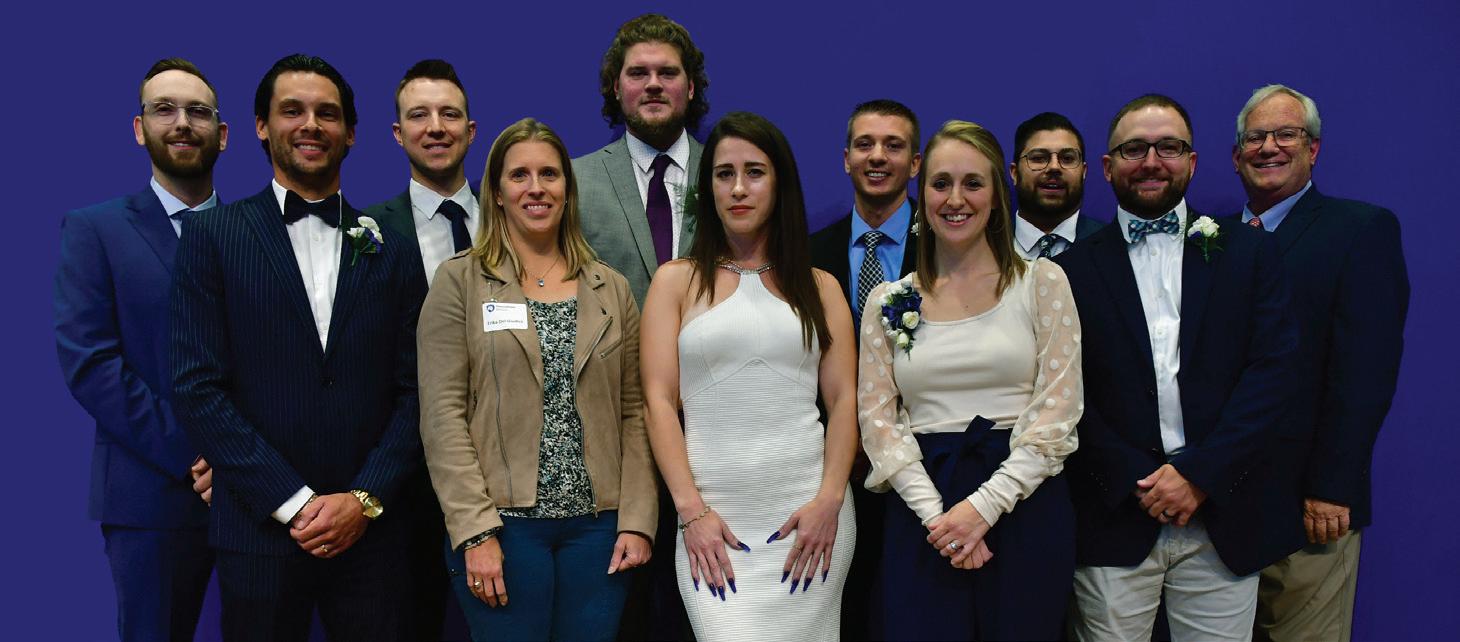

Inducted into Penn State Behrend’s 2023 Athletics Hall of Fame (pictured here with Brian Streeter, senior director of athletics) were, in alphabetical order, Clay Altemose ’13, men’s swimming; Matt Bittner ’13, baseball; Russ Conley ’13, men’s basketball; Jake Gamble ’13, men’s soccer; Dennis Grace ’73, men’s soccer (inducted posthumously); Victoria Harwood ’13, women’s track and field and cross-country; Ryan Jacobs ’13, baseball; Ali Khan ’13, men’s water polo; Ryan Kragnes ’13, baseball; and Valerie (Wagner) Haney ’13, women’s soccer.

MICHAEL GOMBOS ’12 was recently promoted to senior plant engineer at Chelsea Building Products, headquartered in Oakmont, Pennsylvania. Gombos has been with Chelsea since he graduated from Behrend with a degree in Mechanical Engineering Technology in 2012.
Between 2018 and 2019, he helped the company establish a new plant in Greenville, Texas, including renovating a facility, locating equipment, and partnering with local contractors to install electrical and mechanical infrastructure and upgrade the water system. In his new role, Gombos will be the technical lead for all Chelsea locations.

WESLEY SALANDRO, a 2009 Mechanical Engineering graduate, was named a 2023 Delcie Durham Outstanding Young Manufacturing Engineer at the June 2023 conference of SME (Society of Manufacturing Engineers).
The Pittsburgh native launched his engineering career at BMW while still a Ph.D. student in automotive engineering at Clemson University. After completing his doctoral degree, Salandro took a position at the MINI Cooper plant in Oxford, England. Later, he held leadership positions at startups Lucid Motors and Vector Launch.
In 2019, he joined SpaceX. As director of composites production and Falcon stage integration, he leads teams assembling and testing parts on both stages of the Falcon 9 rocket and producing composite assemblies used in the Falcon and Dragon programs.
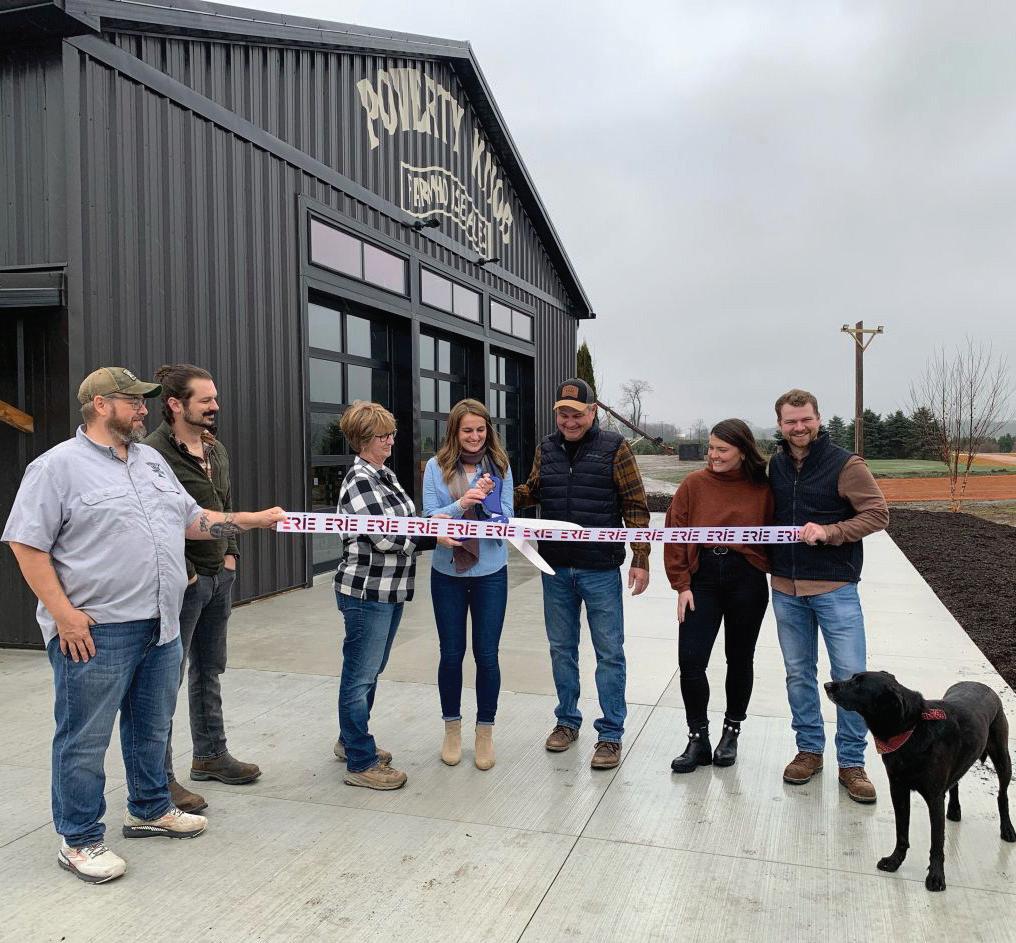
CASEY PORT ’16, ’19 M.B.A., recently left the corporate world to return to her roots and serve as chief operations officer of her family’s business, Port Farms, in Waterford, Pennsylvania.
In addition to operating a pumpkin, squash, wildflower, and Christmas tree farm at 2055 Stone Quarry Road, Port Farms hosts events that draw hundreds of visitors in summer, fall, and winter. The farm’s latest venture is a 6,000-square-foot building that houses a year-round brewery and restaurant named Poverty Knob Farmhouse Ales.
“It was my dad’s idea,” said Port, who came home two years ago to help make it happen. Port has a Project and Supply Chain Management degree and a Master of Business Administration degree from Behrend and is part of the fifth generation of her family to own and run the farm. “We cannot wait to share another part of the farm with our community and invite everyone (pups included) to come check it out.”
The new dog-friendly ten-barrel brewhouse is named for a stretch of poor soil on the 200-acre farm, dubbed Poverty Knob by Port’s great-grandmother. To learn more, visit povertyknobfarmhouseales.com.

Erie-based Oddity Productions, started by three high school friends, two of whom are Behrend graduates—DANNY PAKULSKI, a 2021 Digital Media, Arts, and Technology graduate, and LIAM O’BRIEN, a 2023 International Business and Finance graduate— recently released its second short film.

Portrait of a Universe tells the story of an interstellar impressionist painter, Rodney, who seeks out swirling galaxies and colorful clusters of stars and captures the vastness of our universe in his artwork with the aid of his AI co-pilot, Alice, as they talk about art and humanity. See the trailer at oddityproductions.com.
Eight years ago, brothers and Mechanical Engineering Technology alumni DEREK BROWN ’13 and JASON BROWN ’18 ventured into winemaking, creating coffee wine and exotic wines not generally available for purchase. After years of research and trial and error, they developed several products that family and friends encouraged them to sell commercially.
In 2022, Derek and his wife, Carlie, decided to go all-in and start Jade Winery, named for the first two letters of Jason’s and Derek’s first names. Jade Winery on Donation Road in Waterford, Pennsylvania, opened in November of that year with six varieties of wine. Today, the winery offers fifteen varieties with more to come. “We achieved every one of our 2023 goals and have even more that we look forward to accomplishing in 2024,” Derek said. Visit waterfordjadewine.wixsite.com/jadewinery or follow Jade Winery on facebook.com/jadewinery.
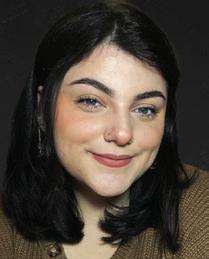
This past fall, English major GABI WATSON was chosen to receive the 2023 ATHENA Young Professional Award, celebrating emerging women leaders in Erie.
During her time at Behrend, Watson, a self-described introvert, grew from observer to participant to executive director of the Lion Entertainment Board, helping to advance the club from four to more than thirty members while developing event planning skills. She was also active in Alternative Spring Break, served as a Welcome Week Leader, and mentored LGBTQIA+ students.

This summer, HALEY ALTADONNA, a senior Biology major, traveled with Dr. Lynne Beaty, assistant professor of biology, to present her research at the Animal Behavior Society meeting in Portland, Oregon. Altadonna presented her work, supervised by Beaty, looking at how surface winds influence behavior and predator-prey interactions in aquatic environments.
Penn State Behrend’s men and women’s swimming and diving teams were recently honored with a Scholar All-America award from the College Swimming Coaches Association of America. To be chosen, the team must have achieved a grade-point average of 3.0 or higher.

One will find few shortcuts at The Juice Jar in Erie, where owner Holly McMaster uses fresh ingredients for the made-from-scratch items on her cafe’s menu. Offering high-quality products and top-notch customer service are McMaster’s priorities, so she wanted to find ways to streamline other time-consuming business tasks.
McMaster reached out to the Black School of Business, which formed an Innovation Through Collaboration project to address her business challenges. By the end of the 15-week project, the team—Jonas Bruno, a sophomore majoring in Finance and Accounting; Brad Dalton, a senior majoring in Management Information Systems (MIS) and Project and Supply Chain Management; and Michael Paul, a senior majoring in MIS and Finance—had accomplished all of the project objectives, and then some.
McMaster has implemented most of the suggestions and said the digitized customer loyalty program the students created has been a tremendous hit with her customers.
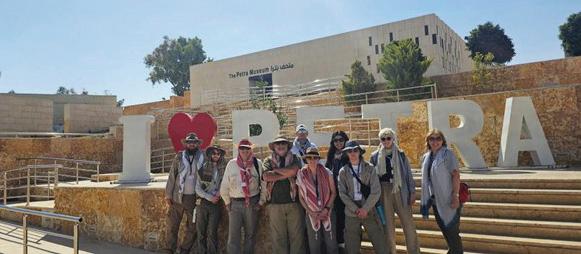
Archaeology magazine named Petra Pool and Garden Complex in Jordan one of eight ancient sites around the world that exemplify humanity’s accomplishments in harvesting and managing water. Dr. Leigh-Ann Bedal, associate professor of anthropology, has been leading excavations of the site since 1998. (Search “Masters of the Desert - Archaeology Magazine” to read the story online.)
Bedal and a team of eleven students, including four Behrend undergraduates—Sean Dailey, Michael Deutsch, Olivia Prevost, and Brandon Way—along with Dr. Gregory Bondar, lecturer in history, were at Petra this summer to continue work on the project.



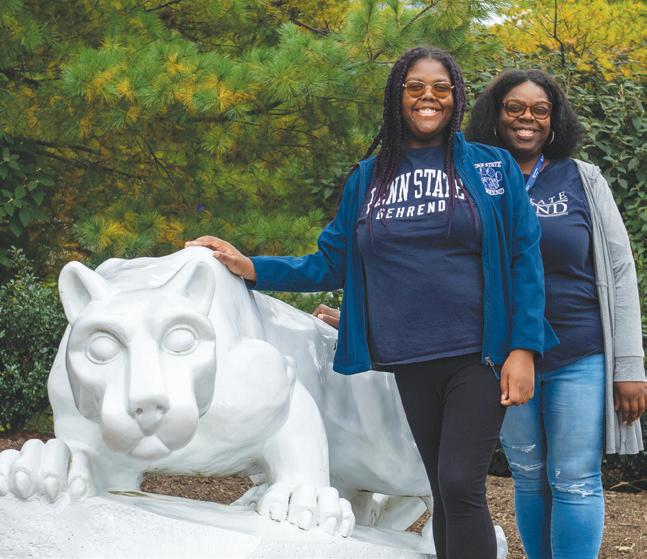


Nearly 2,000 students, parents, alumni, employees, and friends took part in the 2023 Parents, Families & Alumni Weekend, including some of Behrend’s oldest alumni, who were guests at a special “pioneer” reunion event.
From the Friday evening alumni awards and receptions to Saturday’s family carnival and dozens of other activities to Sunday’s Wintergreen Gorge tours, there was no shortage of fun to be found.
The 75th anniversary fireworks on Saturday night, sponsored by Wm. T. Spaeder Company, drew a large crowd that enjoyed a spectacular 20-minute show!